The following Articles and Images have been added to the database
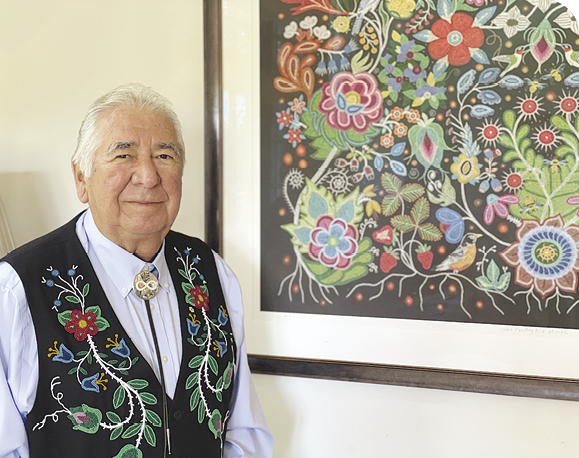
Born in the historic Métis community of Lac Ste. Anne, Alberta, Tony Belcourt’s career spans over 50 years of experience and significant achievement in Indigenous affairs, the corporate, government and not-for-profit sectors. As founding President of the Native Council of Canada (1971-1974), he was instrumental in creating a national voice for Canada’s Métis and Non-Status Indians, and his efforts were an important contributing factor in the Métis being recognized in the Constitution Act, 1982, as one of the Aboriginal peoples of Canada. Mr. Belcourt was the founding President of the Métis Nation of Ontario, and helped to achieve recognition of existing Métis Constitutional rights in the 2003 Supreme Court decision in R v. Powley. He participated in numerous meetings and conferences of the United Nations and the Organization of American States, including the negotiations on the UN Declaration on the Rights of Indigenous Peoples. Tony received the National Aboriginal Achievement Award for Public Service in 2006 and an Honorary Doctorate of Laws from Lakehead University in 2010, and was appointed an Officer of the Order of Canada in 2013.
Now residing in Almonte, Tony recently wrote a letter to The Millstone News <millstonenews.com/flag-at-half-mast-at-mississippi-golf-club/> about his reaction to the flag at the Mississippi Golf Club flying at half-mast for the children of the Kamloops Indian Residential School. In that letter he wrote: “It gives me some hope that we may finally be able to turn the corner on racism and prejudice against Indigenous peoples in this, our home and native land.” That response prompted Millstone reader Fern Martin to suggest that theHumm interview Tony Belcourt, which he very generously agreed to.
theHumm: When a story like the Kamloops Indian Residential School makes the news, what kinds of responses from non-Indigenous people are helpful or welcome to you? Are there responses that are not so helpful?
Tony Belcourt: The response to me personally to me and to my friends at the golf club has been really quite something. Even yesterday, someone I have known for years came up to us and said how sorry he was. I find that a bit embarrassing, I mean – don’t apologize to me. He said he had no idea, he considers himself a pretty intelligent guy, well-read, but he said he had no idea. That kind of surprised me a bit. The other thing he said was that “I wasn’t taught this in school”, which is understandable — I don’t think I was taught it either — and he said “I didn’t get anything in major news media”. And I thought that was strange because the Truth and Reconciliation Commission was really covered from end to end. I guess it must have seemed esoteric to people — no connection or something. But this story has really connected. There’s no question that it has connected. And I do get people who are asking “What can I do?” and so on.
I learned about a group of residential school survivors in Vancouver <irsss.ca/home>, and there’s another group in Victoria <ourplacesociety.com> — I think it was Fern (Martin) who told me about these. And if people are interested in helping the survivors, there’s one way to do it. I’m going to organize a busking jam with my friends in Ottawa, and I want to raise a little bit of money. That’s what I want to do, and I’m going to raise what I can and send it out there. [That event raised over $1,780 for the Residential School Survivors Society <irsss.ca/home>, and you can read more about it here: <rootsmusic.ca/2021/06/23/songs-for-the-revolution-buskers-for-residential-school-survivors/>]
When we spoke on the phone, you mentioned that back in the 19th century people in some of the small towns of the Ottawa Valley had helped to finance the government troops fighting against the Métis in the Battle of Batoche. How can learning more about the history of events like the Battle of Batoche help with relations between settlers and Indigenous people?
Yes, the other thing is for people to learn more about what’s behind the history of the residential schools, and what’s behind the history of deep-seated and systemic racism in Ontario against particularly the Métis people. I’m finding it difficult to figure out how to reach people about that, because it’s still there.
It has its roots in the so-called Riel Rebellions of 1870 and 1885, when the Orange Order in southern Ontario not only influenced but controlled governments — Sir John A MacDonald was one of the most prominent members of that order. The Order’s roots were in Ireland, and the Protestant hatred against the Catholics was at the root, as well as anti-French sentiments. I don’t know if people know about the cabin fires down near Peterborough, where there was a volunteer fire brigade that would burn down anybody who was from Quebec.
In about 1998 or 2000 a group of us had arranged a trip down to Millbrook, which is near Peterborough, to go to the Legion there which was housing its prized possession — the Bell of Batoche. The militia, which had been organized by the Orange Orders in southern Ontario, had volunteered to go out and fight Riel in 1885, and they brought back what they called trophies of war. The bell was a really important thing to the Métis people in Batoche — aside from following traditional spiritual values, Métis people also were Catholic. The churches really went out of their way to baptize anyone they could when they got to the Prairies. And so people became really attached to things like the bell that rang every Sunday and brought people together. Think about the bell in Almonte — when that rings, everybody knows it’s church time! So this was an important trophy.
Now the Legion in Millbrook wasn’t the only place that had these kind of trophies — I’m trying to research other ones as well — and they also had medals that were prized possessions. There were medals from the Battle of Batoche that were in cases along with medals from those who had served in WWI and WWII.
So after Riel was hanged in 1885, what appears to me is that people in Ontario pretty well felt “well, that’s the end of the Métis”. They did not know, or weren’t cognizant of the Métis communities in Ontario, which were pretty well north of the French Line except for huge communities in Georgian Bay. There were Métis communities in and around Pembroke and the islands there, on both sides of the border, but they gradually dissipated, although there are people there now who are descendants and who are just coming forward.
When we started the Métis Nation of Ontario in 1993 and applied for funding from the federal government — which was providing funding to all Indigenous organizations to establish programs for housing, education, health and welfare, and economic development — the government refused to fund the Métis Nation because their official position was that there were no Métis in Ontario. We fought that, and they eventually gave in and said “well, yes, but you have to be organized for two years and have financial statements that prove that you can handle money.”
What eventually happened was that in 1993 one of our people had shot a moose. His name was Steve Powley, and he and his son Roddy shot a moose up in Sault Ste. Marie. In those days our people could get moose tags for a calf but never for a bull moose, which have the really good meat — that’s their sustenance. Even today there are people who supplement whatever earned income they can get, especially if they are working seasonally, with provisions for the winter. So the meat is really important to them, and part of their diet too. Steve was sick and tired of being charged, going to court, paying a fine, going back out and hunting moose but leaving it in the woods until dark and going back in the danger of the evening to cut it up and bring it in. So he said to heck with it — he put his moose on the top of the truck, drove right in front of the Ministry of Natural Resources, went back to his house, and while he was dressing it they charged him. And he refused to go to court and plead guilty. We knew that if he went to court he would lose, unless he had a really good lawyer. I knew this one law firm in Toronto that had gone to the Supreme Court in other aboriginal rights issues for First Nations (nothing had ever gone forward for the Métis). I approached them and asked him if they would take the case. One of their law students was Jean Teillet, who was the great-grand-niece of Louis Riel. She had just graduated and was articling, and she came up to meet Steve and he said “I only have one question — will you pass the bar exams?” She said she would, so Steve said “Ok, then you can be my lawyer”.
We took on the obligation — I made the commitment that we would raise the money [for the case]. We went to court in 1998 — to the Ontario Court in Sault Ste. Marie — and when we got there it became very clear that the Ontario government’s position was: #1 — there were no Métis communities in Ontario; #2 — there never were; #3 — if there ever were, they disappeared; #4 — if those communities ever existed, they never exercised Aboriginal rights according to the Constitution; #5 — if they did, those rights were extinguished; and #6 — if there are communities in Ontario, there was no connection between what may have existed back then and the ones that exist today.
That was their position, but we won hands-down. The judge was very cognizant of the importance of this trial. Then it went to the Superior Court of Ontario and we won there; then it went to the Ontario Court of Appeal where three judges sit, and we won. We got to the Supreme Court of Canada in 2003 and every province in Canada, the two territories at the time and the Federal Government were all on one side, and there was little Jean on the other defending Stevie. And we won. It was a unanimous decision of the Supreme Court that the Métis right to hunt and fish for food was still a Constitutional right — it had not been extinguished. Which raises the question — well, do land rights and other rights still exist in Ontario? How about the right of self-government and self-determination, which are Constitutional rights?
I think it was in 2008 — the year I retired — that the Premier’s office called and asked me to bring my Executive down to the legislature, and they announced that the Government of Ontario was going to officially recognize the Métis Nation. That was phenomenal.
The battle with the Ontario government and particularly the Ministry of Natural Resources and those that have this deep-seated prejudice still exists, unfortunately. On the very positive side of the ledger, the Federal and Provincial governments both agreed to enter into framework agreements in 2017 with the Metis Nation of Ontario and groups out west. It lists all the things that are going to be negotiated. One of the things that isn’t specified yet is land. That’s actually why I came to Ottawa — to fight for land. So those negotiations are going on now.
One of the challenges for people of my vintage is that many of the sources of our historical information were entirely from the settlers’ point of view. Even now, when I Googled the Battle of Batoche, many sources seemed pretty biased. Can you give me any suggestions as to where to look or how to look for sources of information that better represent Indigenous points of view? And/or that could help people become better allies?
Oh boy — that’s a really good question. CBC Radio has some good programs and several Indigenous hosts. The Métis Nation of Ontario has a really good website <metisnation.org>, as do the Chiefs of Ontario <chiefs-of-ontario.org>. Minwaashin Lodge <minlodge.com>in Ottawa helps women who are going through trauma of various kinds. The Inuit have a community centre of their own, and there’s the Odawa Native Friendship Centre <odawa.on.ca>. The Gabriel Dumont Institute <gdins.org> in Saskatchewan is also one of the best sources of Métis information.
I noticed that some of your children are artists and filmmakers. Since theHumm is an arts publication, I’m hoping you can speak to the importance of the arts in the process of healing and reconciliation.
They are all artists in their own right. My daughter Christi Belcourt <christibelcourt.com> is quite well known internationally. Her works are in museums in Europe, in New York, and all across Canada. Her artwork is based on Métis beadwork. The Métis people were called the Flower Beadwork People, and Métis men were the most well-dressed and well-adorned men on the Prairies. Mothers, grandmothers and wives made the clothing for everyone. I grew up wearing moosehide clothing and moccasins — they are just the greatest in the winter. Christi studied the beadwork that has been and is being done, and she started painting floral designs. Then she got the idea of using the point end of a paintbrush to “paint” beads.
Shane Belcourt <shanebelcourt.com> is a filmmaker who has done several features. One of his first was called Tkaronto — which is the original name of Toronto. It’s a story about “guy meets girl” — he’s Métis in Toronto, and she is First Nations from Ontario living in Vancouver. She doesn’t know anything about her culture and he does. It’s really quite a touching story, done on a shoestring budget. Shane has also done a lot of documentaries on Indigenous people. His film Red Rover got a lot of international attention, and now he’s been sought out by some producers in good old Hollywood. He’s also an amazing director. He directed a really interesting television series for APTN called Amplify, where he asks a musical artist to create a song or a piece based on an inspiration — a person, a thing, in some cases a book — and he documents the story of it right from beginning to end.
Suzanne Belcourt is a professional graphic designer and aspiring writer. She was diagnosed with schizophrenia 27 years ago with undiagnosed obsessive-compulsive disorder. For the past twenty years she has designed, among other things, various logos, movie posters, DVD cases, promotional material for directors and producers, as well as CD cases for various musicians. She is currently writing her third screenplay. [Tony was initially hesitant to let us publish Suzanne’s name, but when he called her to ask permission she responded that she would like people to understand that those who have mental illnesses can — and want to — contribute to society in positive ways and that they are often just misunderstood.]
Your extensive career has spanned over 50 years of working on Indigenous affairs. In your opinion, what issues still need addressing?
For me the biggest issue that needs to be addressed is education and dealing with prejudice and myths. Racism is a terrible thing — I grew up having to deal with it, and it still exists. The whole thing with that Muslim family — what is behind all of this? Why are people so indifferent to one-another? You go downtown in Ottawa and there are a lot of street people there — they are the generations that are suffering the ravages of the residential school systems. And it’s not just the Indian residential school systems – it’s orphanages and everything else. And people are so mean to them and indifferent — they don’t want to do anything except walk around and hold their noses. That to me is the biggest issue facing Canadians.
The biggest one still facing the Métis is the loss of our lands. That’s another story people don’t understand. The government took the position that by issuing these pieces of paper called scrip in 1885, they extinguished our rights, and really it was a huge theft of our land.
Have you seen changes over those years that give you hope for relations between Indigenous people and settlers?
Absolutely. And — this is my personal preference — I do not like the word settlers. I don’t consider you a settler — you’re a neighbour. We have a word in Cree that means “all our relations” — wahkôhtiwin. There was a time when there was such a thing as settlers, but people today aren’t settlers. I find it sort of semi-offensive in a way to call someone a settler. There are some groups that call themselves settler organizations, and I don’t know why they do that. I don’t know why that would make them feel good — it doesn’t make me feel good I›ltell you that.
But the answer is yes — there is a great deal going on. There’s a group here in Almonte called All My Relations <mmallmyrelations.ca>, and also the Lanark County Neighbours for Truth and Reconciliation <lanarkcountyneighbours.ca>. They are hosting some very important gatherings.
You can now declutter and support the Carleton Place hospital at the same time!
The Carleton Place & District Memorial Hospital (CPDMH) Foundation is thrilled to announce it has partnered with the Ottawa-based company GiveShop to offer you a way to support your local hospital while decluttering your home at the same time.
GiveShop is an online marketplace with a twist. Similar to Kijiji or Facebook Marketplace, you take a photo of your gently used item, create a posting, pick which charity you want the proceeds to go to, negotiate the sale and arrange for pick-up or shipping. The buyer pays online via GiveShop, who forwards the net proceeds to the Foundation. CPDMH then provides you with a charitable tax receipt for the full value of the sale.
Like it has for most organizations, the pandemic has forced the Foundation to adapt its usual ways of operating. Not being able to rely on traditional fundraising methods, staff and volunteers have been working hard to find new and creative ways to continue this important work.
Not only does the partnership with GiveShop offer a low- or no-contact alternative to traditional yard sales, it also makes it easier than ever for you to support your local hospital!
Why is it important to support the Foundation? Most people aren’t aware that the provincial government does not cover the cost of patient care equipment in hospitals. CPDMH relies on the Foundation to raise the much-needed funds to purchase the patient care equipment the hospital requires.
GiveShop.ca is an excellent option if you need to declutter before putting your house on the market, or if all the time you’ve spent inside has made you realize you just have too much stuff. And if you have nothing to sell, you can always check out the great deals available on the site. Clothing, sports equipment, household items and furniture are just some of the things you’ll find on GiveShop.ca. Just select the Carleton Place & District Memorial Hospital Foundation under “Campaigns”. There’s nothing like finding a great deal and supporting a great cause at the same time!
You must sign up for a free account to post items for sale. For more information, please visit <giveshop.ca> or download the GiveShop app from the Apple App Store or Google Play.

I will be moving to Almonte this October and wanted to pursue some gentle-manly and gentle-ladies hockey. Most leagues in the area had younger players mixed with seniors and in most cases it is difficult to keep up with the young pups.
In the past 15 years when I discovered how much fun hockey could be, I organized different leagues to cater to seniors. By instituting certain rules, players embraced the leagues and it turned out to be a fun, safe, and great way to meet new friends.
I did place an ad on the Friends of Mississippi Facebook page and ended up with 15 players (mixed) that would be interested in pursuing this. The ideal amount would be 20 regulars and at least 10 spares who would enjoy the game that most of us are so impassioned with. After all we do pay to play, unlike the pros.
Games would be at 2pm on Tuesdays and Thursdays. No referees, 5-on-5 with goaltenders.
We are looking for more players to join us, either one or two days per week. Players would be changed every game to allow even lineups and mixing to meet different people.
All level of players are invited to join. I am 77 years young with no aspirations of being scouted by the NHL. I just want to go out and have fun, meet new people and get some exercise in the process without driving too far.
Brent Sullivan of the Carleton Place Canadians will be helping us out by providing jerseys. Thank you to Brent and his organization.
So I must say that this is a great opportunity to get out of the house for a few hours, play some hockey and maybe quaff a few pops after the game… and most importantly analyse what we did right or wrong or simply tease each other.
If you would be interested in joining us, please contact me at <al.foubert@gmail.com>. We would be more than happy to have you join us.
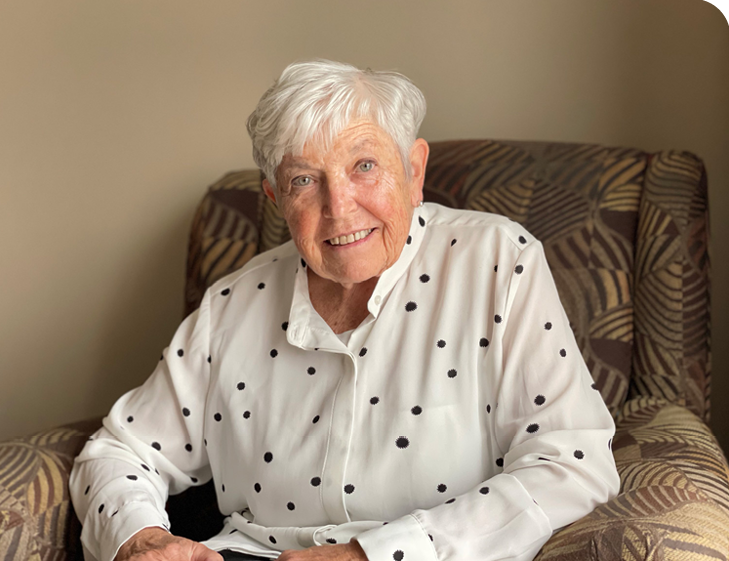
There’s a “thief” in Araina Clark’s life.
“It takes away a lot of things, things you never realized it could, but one by one it marches through and takes….” Araina talks about the thief bluntly: “Reading has become more challenging. The thief took it early.”
She talks about “him” waiting around a corner, waiting to steal again next week, next month, in a few minutes.
“For me, the progression [of Parkinson’s Disease] has been slow, but I felt every loss, was amazed how my life was broken down into so many blocks, tiles, and then disseminated.”
“I was in awe,” Araina says. “I never caught up. I just kept losing, losing, losing…”
“I wouldn’t recommend it,” she adds wryly.
Araina has a lifetime of learning under her belt, and though the thief has quietly and insidiously stolen many things, she’s still learning, tackling life with gusto, passing along what she can.
The diagnosis came in 2005, a short year after she retired from 38 years of nursing. “Then it happened — the start of the thefts.”
Growing up in the ’50s and early ’60s, girls at the time had a choice of two careers — nursing or secretarial work. She didn’t even think about it, she says — she chose nursing and received a Registered Nursing Diploma in Regina in 1967. She and her husband Gord, who worked for the provincial government of Saskatchewan, eventually left the province and headed east to Ontario, where Gord continued his own career (but with the federal government) and Araina continued nursing.
Initially she started at the Heart Institute, working alongside Dr. Wilbert Keon for five years. Then she headed to a paediatric allergist’s office, before walking through the doors of the Queensway-Carleton Hospital. Her evenings were filled with learning and work too. She taught at Algonquin and the National Defence Medical Centre.
“She had five or six balls in the air at one time,” Gord says.
“I learned a lot with [Dr. Keon]. That’s probably where learning cemented with me. I couldn’t get enough, picked up every book, enjoyed what I did.” She says people often asked her why she was driven to read and learn so much. She answered with a certain glint in her eye: “I don’t understand the question”.
Araina knew when her arms began to swing awkwardly as she walked that something was not right; from that time it took her eight years “to admit something was wrong.” She remembers her reaction. “It was not acceptable to me. I needed to get enough education… and still wouldn’t admit it was happening.”
Admitting she had Parkinson’s helped. After that, she began to “make something of it,” but, she says, she will “never really have it completely resolved.”
A move to Almonte was a fresh start that Araina used to make new friends, join committees, put her brain to work on other tasks, move in different directions… and keep learning.
Answering an ad, she became part of a Patient and Family Advisory Committee at the Almonte General Hospital, where she served two three-year terms on the board. “It was what I was looking for. I made friends I would never have met any other way.” Gord adds his own thoughts: “She was a bonus to them. She added a lot of expertise.”
She also joined the Mississippi Mills Accessibility Advisory Committee which she now attends via Zoom. “We’ve made some accessibility changes to the washrooms in Gemmill Park,” and made suggestions to improve both walking surfaces as well as surfaces for wheels of a walker or wheelchair. The committee also made changes at the rink for door openers, and at the library to make it easier for wheelchairs to scoot under shelves.
There’s a just-try-and-stop-me gleam in her eye when she talks about a much-needed restoration of Almonte’s 100-year-old main street infrastructure. “A lot has got to be replaced. We can put our accessibility things where we want.” With some imagination, you can see her rubbing her hands in glee.
And once a week she started to go with some other ladies to a day-away program through Carebridge Community Support, which “gives everybody a break,” she laughs. She knows, too, that her kids have her back, frequently telling her about things they think she could use.
Araina golfed for many years but now accompanies Gord to the course on occasion, riding in the cart, doing a bit of putting and enjoying the socializing at the nineteenth hole. “I’m gonna blow off that thief,” she says grinning, defiance in her soft voice.
Getting back to reading, which is returning bit by bit, Araina says it’s not cognition or eyesight, but rather “comprehension, changing the written word into memory.” She has tried darkening the room, turning off music; everything she could to “induce the essence of reading.” It’s been twelve years since she read a book cover to cover, but she’s working on it.
Dancing is also close to her heart. “There’s a rhythm there. Maybe for everything Parkinson’s takes away, it puts back some rhythm.”
She does wonder at times, though, with all the money put into and raised for Parkinson’s research through the telethons, “where are the successes?”
So she’ll be participating again this year at the Lanark North Leeds Parkinson Canada SuperWalk, which takes place on Saturday, September 11 with a Virtual Opening Ceremony at 11am. At 1pm, registered participants are welcome to join an Exercise Class in Carleton Place, Smiths Falls or Perth, or “Walk Your Own Way” in your neighbourhood. To register, donate, or for more information and details, visit <donate.parkinson.ca/lanarknorthleeds> or call 1–800– 565–3000 x3392. All activities will follow provincial Covid guidelines.
Araina is 75 this year. In her three-quarters of a century she’s nursed for close to four decades, been married for over five decades, has a name that few (if any) others have, has successfully (along with her husband) raised two children, and is now managing Parkinson’s Disease.
She wonders if she learned enough in her life. She thinks sometimes her life hasn’t exactly turned out the way she pictured it — especially when the “thief” came along and screwed up the planning. She asks herself if she’s learned enough.
Then she sits back and realizes she’s still learning…
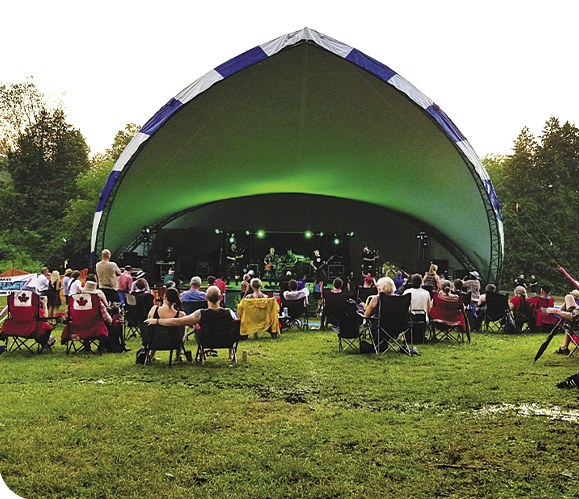
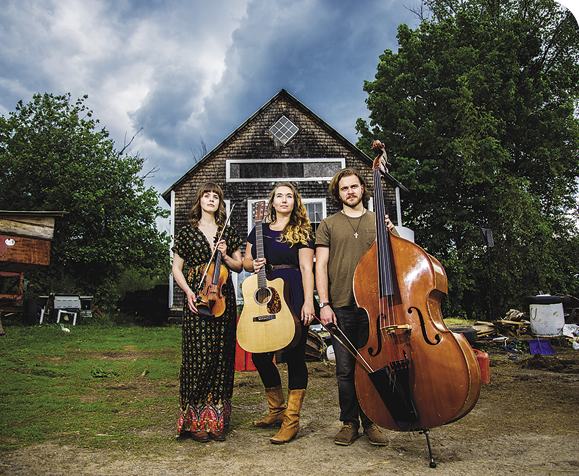
Celtfest is a free afternoon of Ottawa Valley and Celtic entertainment, typically performed in the natural amphitheatre of Gemmill Park in the heart of Almonte, that has moved online <almonteceltfest.com> for the 2020 and 2021 installments of the festival.
It is hard to believe that this long-running event has been bringing the community together in Gemmill Park (and online) to dance, sing, and celebrate all things Celtic for 25 years!
The past few years have been big for Celtfest in so many ways. 2019 marked the biggest festival to date — featuring diverse programming and inviting larger names to the stage in addition to boasting record-breaking attendance numbers. It all seemed to be heading upwards until the world closed and changed for everyone in March 2020. After 23 wondrous years of traditional in-person festival-going, Celtfest made the pivot to an online event in the wake of the 2020 pandemic. While organizers were hoping to return to Gemmill Park for the 25th anniversary celebration, restrictions made it difficult to guarantee anything, and so the decision was made to stick with a virtual festival and online celebrations over the weekend of July 3 & 4, 2021.
The incredible anniversary lineup includes performances from Jessica Pearson and the East Wind, Irish Descendants, Kyle Felhaver, Turpin’s Trail, Broken Bridges, Steel City Rovers, Jessica Wedden, Riverthieves, Terri-Lynn Smith, Kelly Sloan, Mariner’s Curse… and more! More performances will be added, so check social media and the website over the next couple of weeks for full details and stream times. The content is subject to change without notice. The festival will be produced and streamed by Graham Lindsay with Wavelength Media.
Almonte Celtfest will be presenting the O’Connell Scholarship once again for the 2021 edition of the festival. The presentation of the award and winning candidate will feature as part of the festival stream.
The festival’s mission is to celebrate and promote the Celtic heritage of the Ottawa Valley through music and dance, and to make this accessible to all. It offers up-and-coming performers an opportunity to display their talents in their home community. For the 25th anniversary, the festival features a free virtual event with a number of entertainers who hold a Celtic quality, as well as a variety of other virtual content and performances.
The history of Celtfest began in 1997. Motivated by a love of Celtic heritage, Brian and Dan O’Connell, along with Terry Currie, looked for a way to keep their musical traditions alive and pass on the legacy of the Celts to the wider community. Throughout generations, fiddling and stepdancing have had a strong presence in the Ottawa Valley. Celtic music has continued to thrive in kitchens, pubs, and churches, Brian O’Connell explains. “In the early- to mid-90s there was a revival of Celtic music, such as Riverdance. We felt that with all the talent in the area we could put together an event that would promote local musical talent and reflect on the Celtic heritage.”
Almonte Celtfest would like to thank the Town of Mississippi Mills and Heritage Canada for providing funding to ensure this anniversary festival is as wonderful and festive as possible.
With nearly 25 wonderful years behind this festival, it goes without saying that its long life is thanks to the incredible volunteers. Thanks to the founders, the various board and planning committees that have passed the event from one group to the next for 25 years, and the endless list of general volunteers that help with special events, fundraising, or to keep things running during festival weekend. Each person who has donated their time and energy to this festival has made it what it is.
Additionally, thanks are due to the numerous patrons and partners that have supported, participated, and donated to the festival over the past 25 years. Your continued enthusiasm and support is everything. Your passion and involvement have kept this festival alive and growing for 25 years.
And, of course, a major thank you goes out to the performers, musicians, dancers, managers, workshop leaders, buskers, sound engineers and stage technicians for bringing the festival to life with music and entertainment for 25 glorious years.
Join us virtually at <almonteceltfest.com> on July 3 and 4 to celebrate 25 years of Almonte Celtfest. Follow on social media for updates on festival stream times, performer and content announcements, ways to participate virtually, how to donate, and much more!
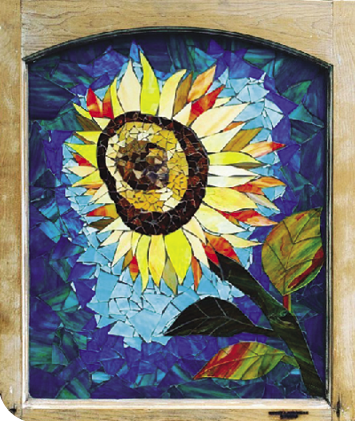
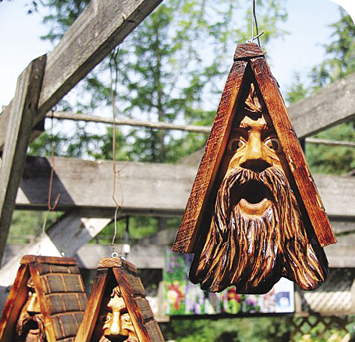
Last year, during the third week of July, Whitehouse Perennials hosted our first garden art show and sale. Late July is a particularly beautiful time because the display gardens and daylily field are in full bloom. It was a great success, and customers and artists were enthusiastic about making it an annual event. Beginning on July 21, the work of 14 artists will be installed throughout the three display gardens and the daylily field. The art will remain in place until August 2. The gardens are extensive, and it is fun to wander the paths and find the art displayed all over the property.
The fourteen artists participating this year include locals as well as some from southern Ontario and Quebec. Last year the work of Rusty Girl attracted a lot of attention, so we are delighted to welcome her back. Featuring practical items like peony rings, trellises, obelisks, bird baths and much more, Clare’s rusty metal creations will fit in any garden. Doug MacDonald from Rue Royale is well known for his cast sculptures of gargoyles and grotesques, whimsical mushrooms and smiling sun faces. He sculpts new pieces each year, so we are looking forward to seeing his latest creations. Morley and Marilyn Labelle of Portshell Crafts have been selling their hand-crafted birdhouses at the nursery this season. The birdhouses shaped like outhouses, log barns and light houses, as well as their feeders, some with unique metal roofs, are both practical and colourful.
Rob and Sue Thomas of A Twist of Metal turn steel and sometimes stone into original sculptures. Fish, herons, owls, flying geese and functional items like trellises all come to life in metal. David Card of Peace of Mind Creations carves one-of-a-kind sculptures of animals, faces and even flowers from wood. He has a quirky sense of humour and his creations will make you smile. Stephane Lavallee of L’art-Verre creates brilliantly painted little houses, framed in cedar wood and decorated using old copper wire. Each little house sits on a sturdy stick that allows you to place it anywhere in the garden that you need a blast of colour.
The benches and end tables of Tuscany Concrete by Design are works of art. Wildlife, birds and landscapes are all captured in concrete with subtle shadings of colours and patterns. Local glass artist Chris Van Zanten makes weatherproof glass totems, whimsies and glass bird feeders in a rainbow of colours. His multi-hued glass bird baths sitting in twisted black metal frames are always popular.
Cindy Laneville, a new artist this year, also works with glass but creates her colourful art using small pieces of glass. Her brilliant mosaics are made into lanterns or framed in old windows and even repurposed antique snowshoes. Also joining us for the first time are artists Sandra Allen and Kevin Wilson of Murkay Creations. Their eye-catching pieces are made by melting and shaping glass rods and sheets of glass. Dragonflies, mobiles and beaded glass wall pieces all catch the sunlight.
Swinging from a tree, lounging on a little branch or just playing around, Raymond Warren’s enchanting ceramic sculptures can decorate your garden or your coffee table. Each one-of-a-kind piece is hand sculpted and then wood fired. This process produces subtle shadings and colours that make the little figures come to life. The work of Frank Sammut, of Kokopelli Woodworking, was recently featured in theHumm. Frank turns locally harvested wood into unique indoor and outdoor furniture that showcases the natural beauty of the wood grain.
Norfolk County artist Colin Logan’s handcrafted metal and stone creations are very whimsical. Stone and metal birds, flying insects and little “creatures” flow from his imagination. Flora and fauna are the inspiration for the wire art and driftwood mobiles of Betty Letendre. Colourful fish and animals sculpted in wire on driftwood bases are perfect for informal garden spaces.
Garden art adds the finishing touch to a garden. You can enjoy a beautiful metal or glass sculpture year-round. A handcrafted birdhouse can provide a nesting spot for one of our feathered friends while adding a splash of colour. A brightly painted sculpture provides colours and textures that cannot be found in plants. This has been another difficult season for artists, with many shows cancelled. We are excited to be able to host this show again and feature the work of these talented individuals. Information about the show and the artists who are attending can be found at <whitehouseperennials.com>. Admission is free.

Lanark County will see many new neighbours move to our towns, villages and countryside in the coming years. All the homes these folks will need must factor into how we manage to slow down and reverse carbon pollution.
The Buildings and Transportation working group of Climate Network Lanark is currently focused on this issue, and its members have expertise in this important part of the climate puzzle. Check out their page at <climatenetworklanark.ca>. It’s worth noting their top mandated item: “Actions to reduce/eliminate greenhouse gas emissions from energy use in buildings and transportation in Lanark County and region by 55% by 2030”.
A big part of this involves working with Lanark County’s Climate Action Plan, as well as Official Plans that the individual municipalities are revising this year, in order to meet this carbon reduction target. Since municipalities can control or influence fully half of all carbon pollution in their regions, we need proactive planning. Critical to creating our Official Plans is to tap into the effective solutions from near and far that offset the big climate problems associated with “urban sprawl.” Currently, when new homes are needed, developers plan new subdivisions, buy swaths of land, and build without many of these important considerations. The province stipulates building codes and provides direction to Official Plans, but municipalities control local land use and practices.
Canadians have had the luxury of living in large new homes on big lots in new developments for many years. My family moved to a new home in a housing development in the west end of Toronto in 1959. Our neighbourhood sat on one of the Golden Horseshoe’s fertile food producing spots: a cherry and apple orchard. A few of these abundantly producing trees were left in between the big energy-sucking homes (our “modern” house had huge floor-to-ceiling windows under which were vents that blasted warm air all winter, as my dad hollered at me to “turn off lights after you leave the room!”). We lived within sight of the four huge smokestacks of the Lakeview Generating Station and its eye-popping mountains of coal. The Lake Ontario shore near us was lined with miles of oil refineries and my town (Port Credit) had the dubious reputation for being the “nose cancer capital of Canada”. I learned to sail at the little harbour, as did all the local kids; keeling our clunky little sailboats frequently into the oil-topped water. The swimming was awful.
I clearly remember living in this mid-20th century model of new housing in expanding small towns. Cute little Port Credit and the neighbouring towns of Lorne Park, Clarkson, Cooksville, Streestville and Brampton are now indistinguishable from one another. We know this area as car-clogged Mississauga. Many of the problematic issues associated with this model of planning are coming closer to us here in Lanark. I am haunted by the spectre of wall-to-wall strip malls, crammed highways and endless solar panel-less rooflines connecting them. After all, I can report that Mississauga used to look exactly like Lanark County. It was a rural paradise spotted with pretty little towns, unique small business along walkable main streets. Old farms vanished faster and faster as the new highways allowed new strip malls and housing to follow.
Granted it has been amazing for so many people to get to live in our prosperous country and have all the modern conveniences of Canadian living: except for one thing. It’s coming back to bite us in a big way via the climate crisis.
I talked with CNL member Doug Smith about the third house he is intending to build: a four-season cottage on the western shore of White Lake. His recollection of overseeing a new house build years ago in Ottawa included several huge dumpsters of building waste being removed from the site. He now regrets this and is clear that his new build won’t be wasteful. He tells me that building waste can comprise around 60% of landfill! His builder has already suggested tweaking his plans to avoid waste in the Insulated Concrete Form (ICF) build. But another factor he spoke about was water use. This isn’t something high on our radar: especially here in the heart of so many beautiful lakes and rivers. But it’s worth noting that in a conversation with a well installer from Calabogie, Doug was told that groundwater is increasingly requiring deeper and deeper wells: 30 to 40 feet deeper on average (farther south in Lanark this figure is 75-100 feet deeper). We do indeed need to think about our water use, and especially what happens to grey water (as is done in many parts of the world). Doug has seen smaller old cottages being replaced with big homes way too close to the water, causing disruption to shore life and water quality. He plans to build back from the water, leaving every possible tree intact. He directed me to Endeavour Centre: The Sustainable Building School for the best information on sustainable building. Check out <endeavourcentre.org>.
We need to follow the example of new builds in more crowded places where they leave their green spaces intact and have chosen to build for a livable future. We now know that green spaces are as important to healthy living as a dry, warm house. We know that healthy communities allow us to walk to do our daily activities. We know that houses can be built to use only the sun and other renewables to run them. We know we can build closer together, with smaller homes, using cars less by having services in our subdivisions, creating 15-minute neighbourhoods like the ones currently being planned in Ottawa. There are many sites you can search for that are filled with information and photos about inspiring “eco neighbourhoods” around the world.
If we follow a mandate of sustainability and plan for vibrant communities using the proven examples at hand, we can hope for Lanark to thrive beautifully in the coming decades.
If you want to know more or contribute to the work with CNL on this or any of the other working groups, please email <lanarkclimate@gmail.ca>.
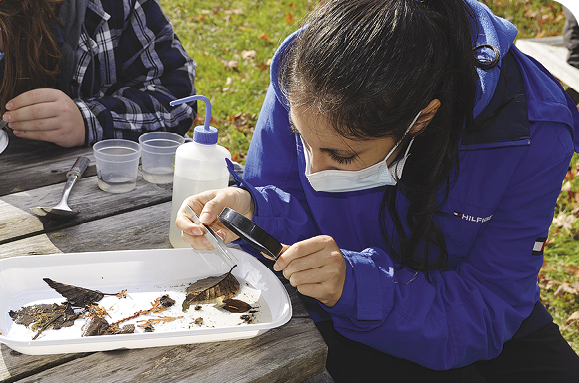
Submitted by Joanna Jack
Youth Circle for Mother Earth (YCME) will be hosting a youth-led BioBlitz across Ontario, online and on-site at the local Plenty Canada headquarters over a two-week period during the month of July. A BioBlitz is an event that involves searching for and identifying as many species as possible over a short period of time. Not only will this event be a fun and exciting way to contribute to crowd-sourced western science, but participating youth will also be contributing to Indigenous-led knowledge and conservation.
Here the key events occurring over the duration of the YCME Bioblitz:
Youth participants will be provided guidelines and resources to begin identifying species in their area from July 9 to July 25.
On July 15 from 7–9pm, Indigenous Ecologist Gary Pritchard will provide an online orientation on how participants can apply Two-Eyed Seeing to the BioBlitz, bringing the best of Indigenous knowledge and western science.
On July 24, an in-person field day will be held at Plenty Canada headquarters for a limited number of pre-registered participants to ensure for Covid safety.
An online closing and wrap-up will follow on August 5 from 6–8pm.
About YCME
YCME is a cross-cultural network of young Indigenous and non-Indigenous leaders becoming lifelong ambassadors for nature and conservation. This network is facilitated by local Indigenous-led organization Plenty Canada, as well as Ontario Nature, Walpole Island Land Trust, and the Indigenous Environmental Institute at Trent University.
About Plenty Canada
Plenty Canada is a registered non-profit organization that facilitates access to and shares resources with Indigenous peoples and other community groups around the world in support of their environmental protection and sustainable development goals. At Plenty Canada we recognize that people are part of the environment and that we sustain healthy lives only when the environment as a whole is healthy. For us, the environment and the biodiversity of our environment is a precious treasure we need to protect.
For more information and to register, please visit <plentycanada.com>.
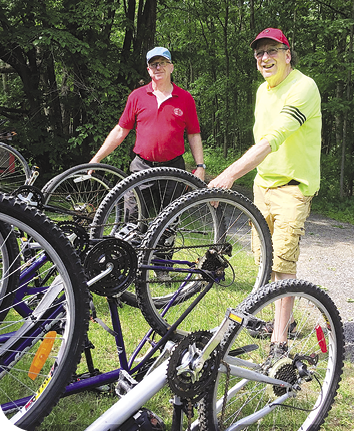
A volunteer group is collecting used bikes throughout Eastern Ontario to send to Cuba, and is asking local people for donations and help.
“More than a million Canadians normally travel to Cuba every year,” says Bill Ryan, who has been donating baseball bats and other needed goods to Cuba through an ongoing volunteer partnership called Cubacan Bats. “A lot of them will want to help their Cuban friends, who have suffered terribly through the pandemic.” Mr. Ryan has been donating baseball bats and other goods to Cuba for eleven years, working in partnership with Gerardo Hernandez, a famous member of Cuba’s National Assembly
Now, Ish Theilheimer, who works with a group in Renfrew County that supplies used bikes to local people who can’t afford them, has teamed up with Ryan and Hernandez. Together, Ryan, Theilheimer and other volunteers are working to fill a shipping container with bikes in good condition and ship them this fall.
“A bike can be a lifeline for a Cuban family,” explains Theilheimer, who has done a lot cycling in Cuba and who brought a used bike to one of the Cubans he has become friends with. “That bike has literally helped the whole family make it through the pandemic,” he says.
When the bikes get to Cuba, Hernandez, who is a Cuban national hero, will ensure the bikes are distributed through his organization, the Committees for the Defence of the Revolution (CDR).
“CDR is the largest community-based organization in the country,” says Ryan, who got to know Hernandez through his efforts to donate baseball bats and whose workshop Hernandez visited when he came to Canada in 2016. “The bikes will find homes across the country. A bike, Gerardo tells us, is equivalent to a car in Cuba. One bike can provide mobility not only to an individual but to a whole family. Even an extended family.”
Cubacan Bikes is setting up a network of collection points in Ottawa, Kingston and other areas. Bikes will be picked up and brought to Cubacan Headquarters for preparation and shipment.
The group is also trying to raise money for shipping the bikes, which could amount to $6,000 or more. For details on donating bikes or money, or information on becoming involved, please visit <cubacanbikes.ca>, phone Bill Ryan (284–0254), or email <cubacanbikes@gmail.com>.

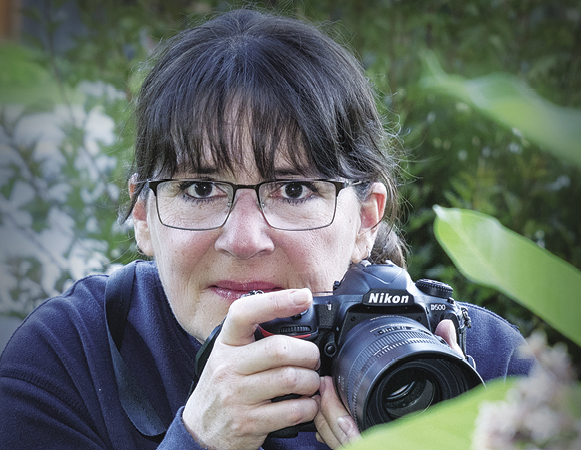
Art… and Soul
“Nature is the place to be,” according to nature and wildlife photographer Danielle Barabé-Bussières. Danielle celebrates her love of the natural world by capturing stunning images and transforming them into works of art. She has a gift for composition, a talent for exploiting the extensive capabilities of current post-processing software, and the dedication and patience needed to create an extraordinary photographic work of art from an excellent photograph.
Take a look at one of her two most popular prints (pictured below). Titled Sleepy Heads, it is an irresistible portrait of two white foxes snuggled close to each other in an archetypical Canadian winter scene. At first glance it looks like a black and white photograph, but closer examination reveals pink noses and a glimmer of colour in one fox’s eyes. The image is compelling — so compelling that in 2020 it garnered Danielle the coveted Photographer of the Year award in the Photographic Artist category of the Professional Photographers of Canada’s (PPOC) annual national competition.
The vision of the PPOC is “To be Canada’s leaders in developing and maintaining the highest level of photographic excellence.” Danielle’s experience as a member is strong evidence that the association is successful, certainly in her case. Since she joined in 2014, her growth as an accredited photographer has been both steady and preeminent. By 2019 she was named Photographic Artist of the Year for the Ontario region. That was just the beginning. PPOC recently announced that Danielle Barabé-Bussières is their 2021 Photographic Artist of The Year for the second year in a row. At press time, a click on <ppoc.ca> features Sleepy Heads as the first image to appear. Her dedication and perseverance have really paid off.
Wildlife (and sport) photographers sometimes debate about the extent to which luck is a factor in their captures, but as anyone who has sat in a blind or crouched in an uncomfortable position for more than an hour will testify, it’s not enough to be lucky. Preparation is key. First there is predictive shooting — you have to know where an opportunity is likely to occur. That takes an enormous amount of research, experience, patience and practice. When that owl finally flies straight at you, or the fox bounds across the field in search of the invisible rodent, your settings have to be perfect, your reflexes have to be superb, your focus has to be spot on, and that’s just the beginning. For a successful artistic shot, the composition has to be outstanding, the lighting has to be dramatic, the action has to be compelling and in sharp focus, the catch light in the animal’s eye should be visible, and there should be no distracting elements obscuring the subject. The single most infuriating comment you can make to a serious photographer is, “Wow! You must have really good equipment.”
Originally from a small village near Trois-Rivières, Québec, Danielle’s first career was as an air traffic controller with the Canadian Armed Forces. Her posting to Shearwater, NS, inspired her to first try her hand at capturing the splendid scenery of the Maritimes. After she became a single mom of two, Danielle created a customer service company on her own so she could have flexible hours. Ten years later her second marriage to a helicopter pilot named Michel added two children to her family, and eventually brought her to Stittsville in 2007. In 2013 when the last of the kids were leaving home, she decided she wanted to get back into photography. Michel bought her a starter Nikon camera as a birthday present, and Danielle started down the familiar photographers’ path of “We don’t need a reason to upgrade.” Her purchase in 2015 of a 200-500mm lens was a game changer, broadening the horizons of her wildlife passion.
Primarily self-taught, she signed up for classes with a master photographer with the intention of setting up a business to do portrait photography. The instructor noted her “extremely good eye for composition and lighting,” and suggested she join PPOC. At first she found it difficult to have her shots rejected by PPOC judges as she worked to achieve accreditation in the categories of nature, ornithology, entomology and wildlife. The peer feedback frustrated and discouraged her, and she quit. But then something clicked. She realized that she would benefit from their criticism and from working to achieve their standards, and decided to rejoin. It took her two years to earn her first accreditation as a wildlife photographer, and she never looked back.
Danielle’s exceptional aesthetic sensibilities set her apart from her peers. Artists frequently paint from photographs; Danielle paints with software on her own photographs. Two years ago she chose an image of a bird that she particularly liked because of its pose and its dramatic feathers, and started to work with post-processing software. The results are extraordinary, as is her dedication. Her candor is refreshing. She freely admits that she literally spent months working on Sleepy Heads. She captured the image of the two white foxes, and then worked for many, many hours “cleaning them up”. Thick, long, white fox fur accumulates dirt, and Danielle painstakingly removed every speck of Nature’s debris from their luxurious coats. She cleaned up the snow too, and the final image has won major awards and is one of her two best-sellers.
Hazy Day in Constance Bay is her other most popular image, and a true reflection of Danielle’s love of nature. She advises, “Nature is the place to be… I can’t imagine anyone not wanting to be in nature. Even when there’s nothing, there’s something if you just sit down and watch.” She feels especially close to nature on the water in their cruiser boat or on her dinghy. She is still working as a public servant, but most mornings she is out watching for mink and ospreys before other people get up. Evenings find her driving back roads where she knows bald eagles hang out, grateful for the GPS on her phone.
One of her pictures is easily worth a thousand words, so I highly recommend browsing <daniellebarabebussieres.com> to share in her ecstatic celebrations of the wonders of Nature. Her glorious images may inspire you to bring one of her custom art prints into your own home to nurture your soul.

Are you prepared for emergencies while hiking? Is your child? Do you have supplies and know how to care for your dog?
Now that provincial restrictions are lifting (knock on wood), mud season is over, and maybe, just maybe, the worst of bug season is behind us — hiking is in full swing! Whether it’s inner-city trails or country escapes, there are plenty of trails (literally hundreds upon hundreds) for us all to enjoy. Safety is sometimes an afterthought when it comes to getting outside; not intentionally of course, but you never really think that anything “bad” will happen to you. So let’s up the odds in your favour by reflecting on some important safety considerations for hiking.
General Advice for Hiking
Love hiking solo? Or being out with little hikers? You can hike with children or alone with confidence by implementing a few safety tips and tricks!
Here are a few hiker safety options that you can easily apply:
Always let someone know your trail, route, and estimated time of return
Choose a more popular trail if hiking solo
Hike in groups and/or bring your dog
Catch up to another group of hikers if someone creeps you
Have your phone on if there is cell reception
Consider an emergency spotter if there’s no cell reception
Never disclose that you are alone
Have a whistle on your person
Do not hike with earphones in or wander off-trail
Consider carrying bear spray (know how and when to use it)
Bring a headlamp and spare if you’re attempting a sunrise or sunset hike
If your gut tells you something is off, return to your vehicle
Carry any medication that you require for 24-48hrs with you
Consider creating and carrying an emergency card with you (your name, emergency contact, family doctor, medication list, current health issues, any significant medical history)
Never post your location on social media until you’ve left the location
Hiking with Children
Think fire drills, but for hiking. Whether it’s an older kid out hiking on their own or younger kiddos with adults, it helps to be prepared and to prepare them for emergencies! If something happens to you while out in nature, does your child know what to do? If a pre-teen/teenager is out on their own and gets turned around, do they know what to do?
Here are a few child-focused safety options to review with children:
How to carry a minimum amount of emergency gear while hiking, and how & when to use it
Always stay on the trail
Location of your emergency card and medicine (in case something happens to you)
How and when to use an emergency whistle
How to send a Google Maps pin drop if there is cell reception
When to call 911 (and that it’s OK to call when lost), and how to call 911 from any smartphone without unlocking it
How to identify significant features, to look back as you walk the trail for recognition, and how to react safely to wildlife (bears, coyotes, deer, etc.)
The dangers of seemingly safe waterways (avoid them)
To only hike with a buddy (older kids) or an adult (younger kids)
To always stay in sight of an adult (younger kids), or to always stick to the planned trail/route and to tell an adult (older kids)
It’s ok to call out for help or ask strangers in an emergency
These are general tips and tricks. It depends of course on the child’s age, ability, and what type of trail you’re on.
Considerations for Hiking with Dogs
We jokingly call them “pandemic puppies”, but there’s no denying that there has been a significant increase in dog owners within the last two years! More and more we’re seeing dogs regularly on trails that permit dogs on-leash, or at off-leash parks.
As the owner, the dog’s wellbeing and impact on the environment is your responsibility, so here are some points to consider for an optimal outdoor experience. When hiking with dog(s), kindly consider the following, and please visit “Ultimate Guide to Hiking with Dogs in Ottawa + Region” on <girlgonegood.com> to understand the impact and reasoning behind them:
Always keep them on-leash in on-leash only designated trails — no exceptions!
Hike within your dog’s limits
Carry extra water and food for them
Check for ticks (including paws, ears, mouth)
Know basic dog first-aid (courses are available in the region)
Carry a dog-specific first aid kit (small and compact)
For longer hikes, consider packing a lightweight cloth dog carrier/stretcher so that you can easily hike them out in an emergency.
By being prepared we can minimize the risk to ourselves and others. It’s part of responsible recreation and the onus is on us to learn, implement, and practice these principles. These are general recommendations of course, and it’s wise to look to leading authorities such as Ontario Parks, local Conservation Authorities, and Leave No Trace Canada for further learning and advice. Cheers to a wonderful year filled with moments of awe in nature!
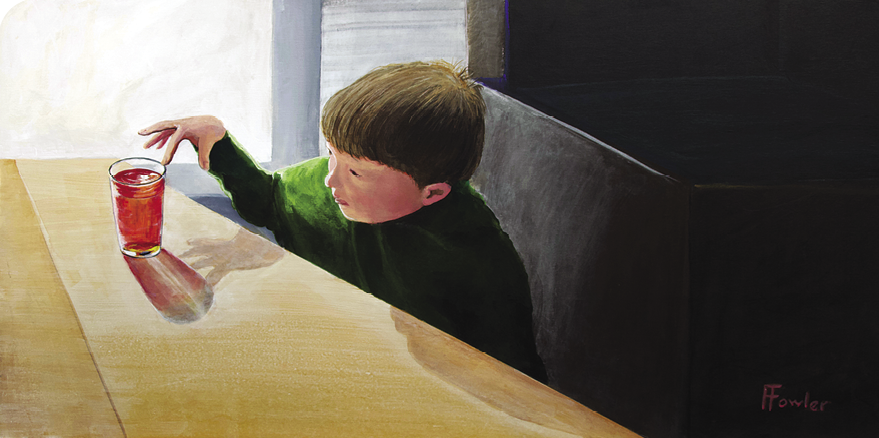
MERA (McDonalds Corners & Elphin Recreation & Arts) is delighted to announce that Fred Fowler is the recipient of the 2021 MERA Award for Excellence in the Fine Arts and Fine Crafts, with runners up Catherine Orfald and Cheryl Straby, in recognition of their excellent work.
Jurors Sunny Kerr (Curator of Contemporary Art at the Agnes Etherington Art Gallery at Queens University in Kingston), Victoria Henry (curator and art critic, and the former Director of the Canada Council Art Bank), and Susie Osler (ceramic artist, and the founder of Fieldwork, a land-based art project in Lanark County), unanimously selected Fred Fowler for the 2021 award.
Susie Osler commented: “Fred’s paintings capture intimate, and very particular, moments in time and space that resonate with enigmatic narrative.” In describing his process, Fred Fowler explains: “I seek to create artwork that is well crafted, done with a ‘good eye’, artwork that works technically and is visibly desirable and will tell a tale and emotionally move the viewer.”
Victoria Henry writes about Catherine Orfald’s paintings: “Orfald responds to the landscape she knows well with fine attention to detail.” Catherine says: “I paint to see more clearly, feel more deeply, and to make stronger connections with the world around me.”
Sunny Kerr writes of Cheryl Straby’s clothing designs: “Cheryl Straby’s work is accomplished in its fearless and vivid design and its meticulous artistry.” Cheryl comments that: “My greatest joy is to continue creating beautiful, sustainable and ethically made wearable art clothing and accessories.”
The MERA Award, consisting of a $1000 prize, will be presented to Fred Fowler at a reception on Friday, September 24 from 4–5:30pm at the Schoolhouse in McDonald’s Corners (Covid permitting). Fred will be showing his work, as will Cheryl Straby and Catherine Orfald. Please contact Helen Mogford at <hmogford@gmail.com> with any questions.
Anyone interested in learning more about the MERA Award is invited to send an email to <meraschoolhouse@gmail.com> or to visit <meraschoolhouse.org>. The next award will be given in 2023.
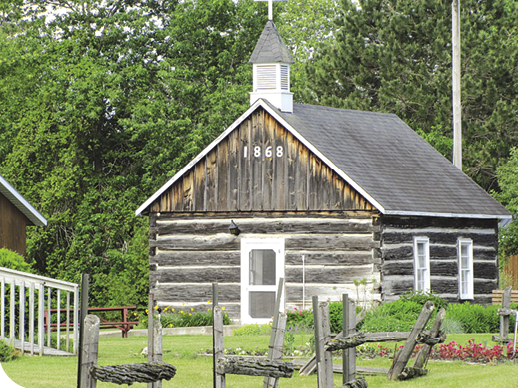
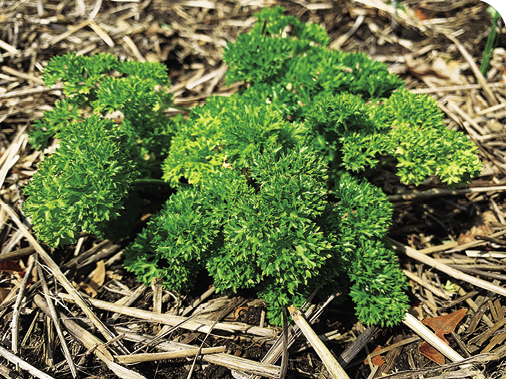
MidSummer Herbfest is going virtual again in 2021 with a week-long event running from Sunday, July 25 to Sunday, August 1. Stay tuned to <midsummerherbfest.ca> for more details about this celebration of healthy living. This year, Herbfest will be showcasing parsley — the international herb of the year. You’ll find musical sets from Ottawa Valley artists Vicki Brittle and Khloe B Music, as well as online vendors, videos, kids’ crafts, and raffle prizes.
Organizers are also looking forward to seeing everyone again in person on Sunday, July 24, 2022!
Herbfest History
Prior to locating in White Lake at the beautiful Waba Cottage and Gardens, Herbfest enjoyed twenty successful years at the Herb Garden facility near Almonte. That venue was an operating nursery which could be rented for weddings or other special occasions. Gerry and George, who owned the facility, put their special touches on all events based out of their gorgeous facility, and Herbfest flourished over the years, often attracting upwards of 2000 attendees.
When Gerry and George decided to slow down and consider retirement options, moving their beloved Herbfest on to appropriate owners was top-of-mind. Since they were passionate travelers, they agreed that the future site to host Herbfest would have to have significant aesthetic appeal. After stumbling upon Waba Cottage Museum and Gardens in White Lake and immediately falling in love with it, the couple lobbied McNab/Braeside Township to purchase the brand and continue the tradition in the magnificent lakeside setting at the Museum site, where gardens pop and people who get to experience the unique venue never forget it!
Several very successful Herbfest events were executed on-site in McNab/Braeside Township prior to the pandemic, attracting hundreds and hundreds of folks and showcasing products relating to healthy lifestyles. Organizers are hoping to get back on-site next year, but this second virtual Herbfest is meant to expose people to new trends, businesses, experiences and products as they pertain to health, the environment, or local significance. Check out <midsummerherbfest.ca> and see for yourself what the Herbfest buzz is all about!


As we emerge from months of lockdown and take our first tentative steps back into the “real” world, one of the first experiences many of us are seeking is that of live performances. Remember that elusive but transformative feeling of sharing a great vibe with musicians and fellow audience members? Tapping your feet and grooving along, mouthing the words to your favourite songs? Fortunately for the Ottawa Valley, Barb (Mattiacci) McIlquham recalls all those great feelings, having experienced them both as a performer and a live music lover. Her desire to help musicians get gigging again led her to offer up her home at Daisy Dell Farm as a venue for intimate outdoor concerts this summer. We contacted Barb to find out more.
theHumm: Let’s start with the line-up. Who have you got coming to play, and how did you choose those particular performers?
Barb McIlquham: We wanted to hold a concert here last summer with Rick Fines, but it was very late in the season when we thought of it, so we decided on this year. When we got in touch with Rick in the new year he was all for it, so we had the idea of making it into a concert series with one concert per month starting from May to October. Rick agreed to kick things off in May. Once the lockdown happened though, we had to postpone his concert until July 24. I have known Rick since the 1980s when I lived in Peterborough. He is an awesome musician, writer and performer. I have had a few occasions to play with him and it’s always fun.
Marie-Lynn Hammond is coming on July 17. I have been a fan of hers since hearing her in Stringband when I was a teenager and just beginning my own music career. So you could say she had an effect on my style and love of acoustic music.
On August 21 Ian Tamblyn will be performing. I am really excited about this as I have listened to his music for so many years. I love his guitar playing and voice. His music is always my number-one choice when I need to chill out. Then on September 11 Washboard Hank will be here. I have known Hank since my Peterborough days and he never disappoints with his humour, musicality and performance style. He is one in a million that’s for sure.
For the end of the concert series, I will be playing under my stage name Barb Mattiacci on October 2. I’ve been busy performing and recording kids’ music for the past few years, so I am really happy to be stepping away from that and to be playing for a wider audience again. I will be playing some newly written material as well as stuff from a previous album. I always throw in a few cover tunes too.
So, needless to say, the line-up started with my love for all of the performers’ music. I know that many of them have lots of fans in the area as well.
Tell us a bit about how you and your husband ended up at Daisy Dell, and why it makes a great musical venue.
We are so fortunate to call Perth our home. My husband Scott is from Peterborough, and we met years ago when I lived there. We found ourselves in the Hamilton area for many years, raising our kids to be close to my family (I am originally from Burlington). We always had this dream that once the kids were out of high school we would find a place in the country. Well, we found the place and couldn’t be happier. We have been here for two years now. We have horses, chickens and barn cats. There are lots of forests and fields and we even have a yurt that we rent out on Airbnb. The setting is pretty idyllic. We have a riding ring for the horses that has covered stage platforms. One day as I was walking up the path, I stopped and looked at the platform and thought, “that is a perfect stage and setting for an outdoor concert.” Then the wheels started turning!
What can audiences expect when they attend an outdoor concert at Daisy Dell?
It’s a beautiful setting — peaceful, fresh air, birds chirping. In front of the stage is a beautiful grassed area with perfectly spaced trees. When people purchase their tickets, we ask that they bring their own lawnchairs, blankets, coolers with drinks, bug spray and an umbrella. It’s very comfortable and laid back. We are only selling 25 tickets per concert so the size of the audience will be just enough to make it a cozy and intimate setting.
You are a musician in your own right, with a couple of CDs and a long history of performing under your belt. What have those experiences taught you about the live music scene in Canada?
For me, the live performance is one of the driving forces that enables me to share all of my creative thoughts and music. The interaction between a listening audience and the performer is essential to understanding the art of the music when played live. When you craft a song, you want to share it. It’s part of the process, at least for me. This last year has been so hard for musicians — not only financially and artistically, but also because of that rare gift of exchange that many musicians benefit from when they are singing and playing to a live audience. The audience response, the interaction, the smiles, the reassurance — it’s all so vital.
I notice that almost all of the ticket price goes directly to the performers. Why is it so important to support our Canadian musicians, particularly right now?
We intend to fully support the musicians. As everyone knows, it’s been a rough year financially. We have the space, we have the stage, we have the will and enthusiasm, so why not share that?
Tickets for all shows are $30 each, available from Tickets Please <ticketsplease.ca>. For up-to-date details, follow Daisy Dell Farm on Facebook.

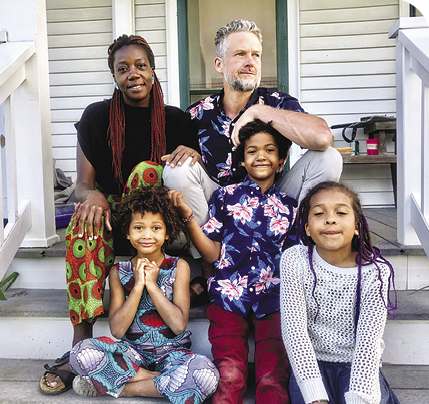
My name is Renée Kokonya Sullivan. I am from Kenya and have been living in Canada now for four years. I didn’t have a library growing up. I loved to read though. My only books were my textbooks from school. I loved reading through them, especially my English and Swahili books. The first time I entered a library was in university. I was in awe! So many books, such little time. I was hooked. Libraries and bookstores became some of my favourite places to hang out. I loved the smell of books, the quiet and the endless possibility of dreams that books provided. When I moved to Canada, the library was one of the first places that I went with my children. We went often and borrowed so many, too many books each time. It was so exciting to get home and read all the books, until we began to notice that something was missing. There was a huge absence of people who looked like us in the books that we read! My 5-year-old daughter also noticed. She asked me with tears in her eyes: “Mama, why is it that most books have peach people and not brown people like me?” It broke my heart!
This past February, my husband Bart and I hosted the Annual Almonte Black History Month Dance Party for a second time. In February 2020, we hosted the dance party at the Almonte Curling Club and raised $500 for Britannia Woods Community House in Ottawa. This is an organization that offers a range of programs and services for Black children, youth and their families, including offering support to families with free afterschool programming, free basketball programs, and helping youth connect with their peers and meet positive mentors and role models. We had a great time dancing, with three DJs on deck, for a very good cause, and for many of us it was the last party before the pandemic began. This year we hosted an online dance party and were greatly encouraged by the enthusiasm from our community. We had a great time dancing in our own homes, and it was so fun to see how much people got into it — dressing up, making special cocktails (no need to worry about drinking and driving), and showing off their dance moves. A great time was had by all and we raised $700, which we used to buy books by Black authors, from a Black-owned bookstore <knowledgebookstore.com>, that would be donated to the Almonte library.
It is one thing to say that everyone is welcome in our friendly town, but if some people don’t see themselves in their user experience of our public spaces, then it’s just talk. Actions always beat intentions. The past year has shown us just how much need there is for diverse voices in our society. As a member of this community, I decided that it was my job to create the change that I wanted to see. I was so glad to be joined by many other members of our community, who made generous contributions to this wonderful cause that also supported a Black-owned business. And I am happy to see that our library has already started to respond to requests from the community for diversity and has added quite a number of books by Black authors.
Watching the excitement in my three mixed children when the books arrived and they saw people that looked like them was wonderful! I hope other children and adults of Colour in our community will have the same experience. These books, though, are for everyone; diverse reading is good for all of us. I am so excited for the new books to go into circulation. There board books for babies, children’s books, books on Black Canadian trailblazers, Black inventors, strong Black women, fantasy, adventure and biographies.
Thank you to everyone who made a generous contribution to our cause. We would not have been able to do this without you. The library is always taking donations of cash and books. Please let them know if you would specifically like your donation to be used to add to the collection by Black authors. If you would like to take part in more dance parties for a cause, follow Stonecroft Sessions on Facebook.
There are other things that you can do to be a co-conspirator in the fight for diversity and inclusion. Remember to listen without jumping in when a person of colour shares their experience. If you are an employer, hire, retain and promote people of colour. Give your time in an organization involved with communities of colour. Provide diverse books and toys to your children. Fight for equal education for kids of all races. Let us all make a commitment to make our friendly town truly inclusive. We have the power to create the world that we want to live in.
Organizations you can support include:
<britanniawoods.com>
<knowledgebookstore.com>
<613819blackhubnoir.ca>
<acaottawa.com>
<equalchance.ca>
<blackottawascene.com>
<sankofabooks.com>
89.1 CHUO FMRenée Kokonya Sullivan
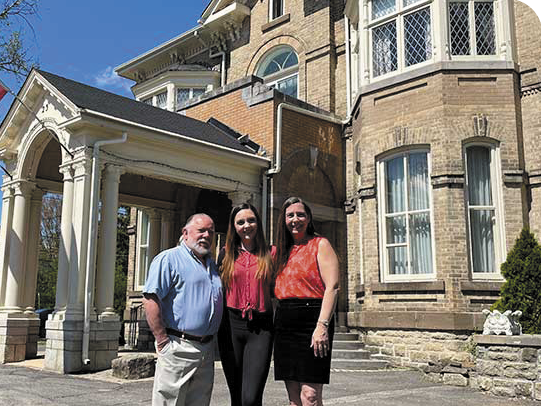
Gordon and Linda Craig have owned and run the Perth Manor Boutique Hotel for the past ten years, during which time they have made many contributions to the cultural and musical scene in the Ottawa Valley. From their popular (and delicious) New Year’s Eve celebrations to “Music at the Manor” events and workshops, they have been regular contributors to theHumm’s calendar pages. We were sad to hear that they will be stepping away from the Manor later on this year, so we contacted them to find out more about their plans, and about the past and future of the gracious house on Drummond Street West.
theHumm: The Perth Manor was built back in 1878, so it has seen a whole lot of the Town’s history. Can you describe some of the heritage character of the home that makes it such an icon?
Linda Craig: Where do I start? This building is so tightly connected to the town. It was built by a fellow named Henderson, who purchased the land for The Manor and had the house built for 12,000 pounds. When he passed away, his daughter Jessie Mabel stayed on here and married John Stewart — also very wealthy, and quite political — he was mayor of the town for two terms and a member of parliament for Railways and Canals. Stewart Park, Stewart School, Stewart Street — the Stewarts were quite a prominent family in town!
The Stewarts made many upgrades to the building, including adding the back half of the Manor for the servants. They had an upstairs maid, a downstairs maid, a cook (one of whom I met — she just turned 95 last fall), a butler, a nurse for Jessie’s mother, a chauffeur and a nice lady who came once a week to polish the silver. They also had two gardeners who lived in town and came in to look after the property.
When Mr. Stewart passed away, Jessie Mabel designed and dedicated Stewart Park in her husband’s memory. She gave the land for the park to the town with the proviso that there was never to be any commerce in the park, or admission charged to use the park — this is why the Stewart Park Music Festival and other events in the park are free of charge to this day.
What was it about the Perth Manor that first drew your eye and made you think “hey — we should run an inn!”?
It was all by chance really. Gordon had wanted a restaurant for years and I had put my feet firmly in concrete and said “no way!” We stumbled across the Manor when we were visiting friends with a cottage on Pike Lake. The next thing I knew we had an appointment to look at it and were meeting with our real estate agent to put our house in Kingston on the market!
The timing was right for us, as our daughter Tyanna was changing schools, I was at the top of what I was doing career-wise and ready for a change, and Gordon was nearing retirement from Queen’s University School of Music. The property was an opportunity for me to change career paths and for Gordon to stretch his restaurateur wings — with the added bonus that I didn’t have to own a restaurant!
You both come from a musical background and have done a wonderful job of integrating music into the life of the Manor. What were some highlights for you over the past decade?
Yes, Gordon and I both play/played with the Kingston Symphony — Gordon recently retired, and he taught in the Music department at Queen’s for over 40 years, so we have a lot of musical contacts. We started a chamber music series here, we have done jazz nights that have been a lot of fun, but I think the most fun we had was with our musical dinners. We would pick a country or city, Gordon would create a six-course meal inspired by the location, and we would bring in a musical guest to play between courses.
We have featured some really amazing artists. Bruce Kelly (baritone) and Michel Szczesniak (piano) played for our Evening in Paris dinner; harpist Sharlene Wallace has played here a few times and was a huge success at our Tribute to Ireland dinner; we had Canadian Fiddle Hall of Famer Kelly Trottier for our Canada 150th celebration, and my daughter step-danced with her! These events really stand out — they allowed us to combine our two loves: music and food. Add in some wine and we’re all set! And Gordon would often sit in or make cameo appearances with his clarinet. These dinners came to a halt because of Covid, but with a little creative thinking last summer we started workshop weeks for harp, fiddle and cello which we could run according to safety protocols. They were very special during a time when people really needed shared, in-person experiences. They could play music together safely, socialize on the terrace, had historical tours with our beloved town crier (and Queen’s Music grad) Brent McLaren, and Gordon cooked a fancy meal for them — it was very special.
It makes me kind of wistful to think that this gracious building will no longer be accessible to the public, as it is being purchased as a private residence. How are you encouraging people to experience the grand Manor one last time?
I share that wistful feeling. I would like to have as many people as possible through here over the summer because it makes me sad that people will lose the opportunity to really experience a taste of what it was like to live in a slower, grander, more elegant time. So much of The Manor has maintained its original footprint over the years — you really do instantly step back in time. It’s a very special feeling. Not to mention the stunning gardens — two city lots of garden to wander is quite beautiful this time of year. To encourage people to take advantage of this last opportunity, we have two promotions going on. Coincidentally it is our tenth anniversary here, so we are offering a 10% discount to guests returning to have one last visit at the Manor. And for new guests — people just discovering us or those who always wanted to stay but just never got around to it — we are offering a multi-night booking special: stay two or more nights and receive a $20 discount the second night onwards. To take advantage of these offers, bookings have to be made directly with us either by calling 264-0050 x1 or visiting our website <perthmanor.com>, where guests can fill out a secure reservation form when they click the Book a Room button.
What are your own plans for the future?
Well, if you ask Gordon, he is looking to move to Costa Rica. I told him to send a postcard! We do love the Perth area though, so we are looking to stay fairly close. We are hoping to build on a little piece of land in the process of being severed — hopefully that goes smoothly (famous last words, I know). The plan is for Gordon to finally be completely retired from the half-dozen careers he was juggling, and for me to be a bit freer to roam where family needs me. Who knows, maybe I’ll pick up a low-stress, part-time job somewhere!
I have really enjoyed my time here at The Manor, but I also feel ready to move on. What I have discovered as our closing date draws closer and I think about doing things “for the last time” — like when I’m checking guests in and telling them about the history they are walking into — I realize that the stories I’m telling are at risk of being lost. I think my first project will be to compile all of my stories, newspaper clippings, pictures, etc. that I have accumulated into some semblance of order and put them into a self-published book. My goal is to complete this and print enough copies to give one to each of the Manor’s owners to have as a keepsake of all of our time here. Our chapter here is done, but there is still at least one more chapter to come — hopefully future owners will publish Volume 2!
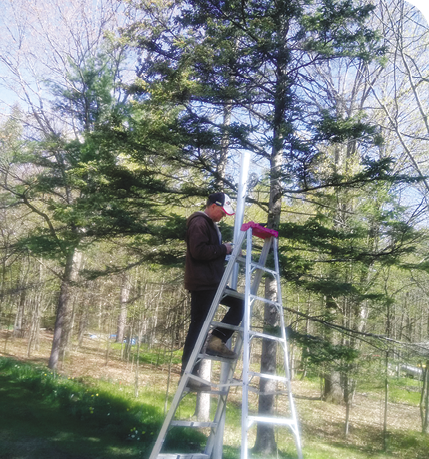
My clothesline suffered a slow and painful collapse one day last fall, and after a couple of estimates I convinced myself I could use a lot of dryer time for what it was going to cost to erect a 14-foot pole and re-string that line. But every wash day through the winter I yearned for the fresh smell of frozen laundry. I was tired of lint on the dark clothes, jeans shrinking, socks disappearing, everything in a wrinkled tangle like day-old spaghetti. I needed that clothesline.
A casual conversation with our neighbour Harold did the trick. A few days later he arrived with his front end loader to dig a veritable cavern five feet deep and four across. How he manoeuvered that machine without disturbing my very expensive lilies was a miracle to me. Boulders as big as baby buggies were pushed aside as he scooped out the huge hole and shovelled in the concrete. We watched with envy, marvelling over the difference the right tool can make to doing a job properly. In a matter of hours the metal pole with hooks attached was standing perfectly upright and level from all angles. Jerried into place with guy ropes attached to trees and the tractor, all we had to do was wait ’til the concrete set, and our faithful neighbour got up on the high ladder to string the line and pulleys. I was ecstatic!
Is it crazy to be excited by something as basic as a clothesline? Not to me it isn’t. Within an hour, the washing machine was going full tilt. I bought new clothespins to mark the occasion, and with great ceremony strung out a full line of wash as soon as it was ready.
Now, the real joy is bringing the clothes back in. Everything can be folded in one step, and because it was hung in sequence, there isn’t a towel hidden in the corner of a fitted sheet, or a sock sticking to the back of a shirt. We can do without that fashion statement.
We are so grateful to live in our Carroll Side Road neighbourhood. All the men have “big boy toys”, and mercifully are willing to help when we need them. They often will offer before we ask, making the tasks we couldn’t accomplish a mere blip in their day. Harold has moved rocks, maintained our trails, chipped wood, and installed our clothesline. Bob has split wood for us, and cut down trees we can’t tackle. Both of them have shared their excellent maple syrup. Alex has helped keep our trails open when wind has brought down big trees we can’t handle, and supplies us with rhubarb in the spring. This is only a short list of the generosity our neighbours bestow on us.
We moved here 27 years ago when we were young and fit enough to do a lot of the things that now have become heavy labour. We couldn’t imagine living anywhere else, but we know we’d be hard pressed to stay if it weren’t for the gracious benevolence of our good neighbours, these helpful men and their lovely wives too.
Every day I take pleasure in the small things, like my clothesline. As we watch our precious trees being destroyed with Gypsy Moth caterpillars, we are enjoying seeing the birds we usually only hear in the canopy. We are renting a birdhouse to a chickadee that’s doing her best to eat as many worms as she can. There is a cardinal and a scarlet tanager making a trio with a rose-breasted grosbeak, so close we can nearly touch them.
We used to have a big vegetable garden, but now it’s three containers where peppers and cucumbers are battling for space with tomatoes and geraniums. I love to see the progress daily, as long as the grasshoppers don’t get there first.
Even the rain becomes a treat after days of scorching drought, no matter if it’s a weekend or not. As we say so often, “It’s all good”.
So, thanks to our good friends, we are launching into summer with renewed pleasure to be taken in small things like a proper clothesline. I am sure this will be the last instalment of the saga, as this pole is never coming down!
The dryer sits idle in the laundry room. It’ll be a long time before I need it. Once again, it’s become a place to pile stuff.

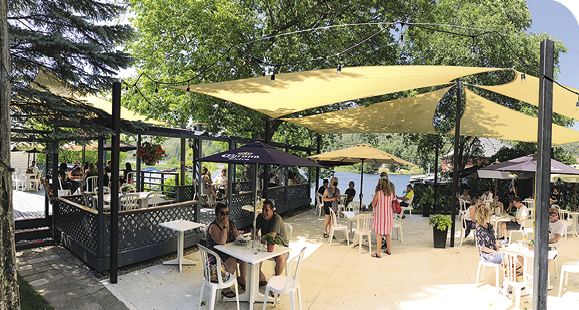
With live music venues set to open outdoors again, I actually feel a little silly trying to write about the transformative power of live music. I can’t, really. Because that power comes from the genuine human experience between musician and audience — and that transformative power is created live. In the moment. With music and voice, spontaneous gestures and impossible-to-describe feelings. And anyone who loves live music knows that. They don’t need it explained to them; they merely need to hear the music… live.
And now, after a very, very long year and four months without live music, well — they can. And two of the Ottawa Valley’s premier live music venues are pretty jazzed about that.
“Live entertainment is such an important piece of life,” says Mark Enright, one of three owners of Burnstown’s Neat Coffee House — now practically a legendary venue known for hosting truly top-calibre live music throughout the years.
“Live music is part of our heartbeat,” Enright says. “I truly believe it is amazing for mental health, and the experience of live music is second to nothing!”
With that in mind, Neat Coffee House is going, as Stephen King might say, “full-tilt boogie” with its live music lineup for July. And for the rest of the summer, for that matter. They’ll be hosting an impressive line-up of Canadian bands and musicians, including Bif Naked, The Sadies, Terra Lightfoot, Elliott Brood, Great Lake Swimmers and many more.
“I think when all these restrictions relax,” Enright says, “live music will come back stronger than ever. The pandemic has provided a new perspective on life in general, I think — I believe we will appreciate things a bit more now, especially the live music experience.”
Enright says Neat is doing its best to support Canadian artists by getting the shows rolling again starting on July 1. Buying a ticket to a show gets artists paid, he points out, “which is amazing news after a long break.”
The way people can support both the musicians and the café, Enright says, is by choosing the “Ticket with dinner reservation” when booking their seats. That option gets you a delicious meal before the show starts. And “if people are not interested in shows,” he notes, “they can support us by eating on the patio, ordering takeout, buying gift certificates or Neat merchandise.”
You can purchase tickets for shows (with dinner reservations!) at <neatmusicandcoffee.ca>. You’ll find more information there about their food, coffee, and merch; you can also follow them on Facebook, Twitter and Instagram.
The folks at Neat will be following all health protocols for their concert series as well as dining outdoors at the café. “We have tables and concert chairs all spaced out 6-feet apart and we are following all protocols with masking, sanitizing, contact tracing, et cetera,” Enright says. “Not an easy task, but after a year-and-a-half it’s almost second nature now.”
Over the years, The Cove Inn in Westport has also developed a reputation as one of the best spots in the Ottawa Valley to see and hear live music from a broad range of truly talented musicians. That’s the plan again this summer, says manager Seamus Cowan, beginning on June 30 when the province’s Step 2 re-opening plans will allow live music venues to open their outdoor venues again.
“We plan to have live music nightly on our waterfront patio,” Seamus says, with “large event waterside shows” as well. In June The Cove opened its newly renovated waterfront patio, and so far it’s been a huge hit with customers, both loyal and new. It also looks like the perfect place to sit with a friend or two and enjoy some great live music.
Seamus is with Mark Enright on this one — he says the best way to support both musicians and local businesses is to get on out to a show.
“Live music is one of the main pillars of our business,” he says. “We breathe music and especially live music here at The Cove. We can’t wait until we have it again, as it has become one our main attractions. Come to our newly renovated waterfront patio and safely enjoy food and beverages with family and friends!”
As they have throughout the pandemic, The Cove will be following all health and safety protocols, which means mandatory masks, sanitizing hands, social distancing of tables, and honouring the maximum number of patrons per table — as well as distancing musicians from patrons and sanitizing all menus, chairs and tables after each use.
Takeout is available too, Seamus says, if the patio is packed — and knowing how badly people want to get out and enjoy good food, great music and a pint or two with family and friends, they just might be quite busy. No worries, says Seamus. “If our tables are full, you can order takeout and drinks and eat at the waterside picnic tables.” It’s best to make a reservation in advance to be assured a table, he adds, as they have limited capacity due to social distancing of tables.
To reserve a spot on The Cove’s newly expanded (and quite lovely-looking) patio, you can call 273–3636. And be sure to keep an eye on The Cove’s website <coveinn.com>and Facebook page for their live summer music schedule. They never fail in staging exceptional and wonderfully memorable concerts, so be sure to set yourself down at The Cove for a meal and a show this summer.
Also be sure to check in with all your favourite venues — from Bowie’s in Smiths Falls to O’Reilly’s in Perth — to see when they’ll be expecting to host live music again on their patios. It’s been a long drought for everyone, but there’s beautiful noise just around the bend — and joy, laughter and good times too.
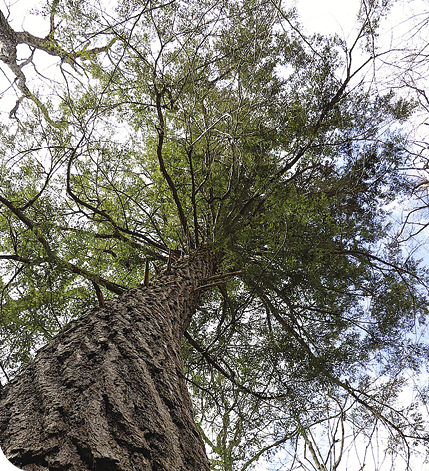

Submitted by Carolyn Piche
It’s no secret that our forests and wetlands provide us with countless environmental and health benefits. Being in wild areas can lead to improved emotional, spiritual and physical wellbeing, while Nature purifies our air and water. Wild areas are also a key resource in our efforts to slow climate change because they sequester large amounts of carbon from the atmosphere.
Were you among the thousands who visited the Mississippi Madawaska Land Trust (MMLT) properties over the past 15 months, seeking a reprieve from the confines of Covid-19? Since hiking trails and natural spaces were some of the few safe recreational destinations available to us, you may have been among the unprecedented number of visitors to the four public MMLT Nature Reserves: High Lonesome Nature Reserve (Pakenham), cliffLAND (Blueberry Mountain near Lanark), Poole Family Nature Sanctuary (Carleton Place), and Rose Hill Nature Reserve (Denbigh).
Visitors have told our volunteers that walking our trails reduces their stress levels, provides much-needed physical activity, encourages artistic inspiration and offers longed-for connection with nature —whether it be birdwatching or simply immersing themselves in the beauty.
MMLT is a volunteer-based charity committed to ensuring that wild landscapes within the Mississippi and Lower Madawaska watersheds are protected for us, our children and grandchildren. MMLT stewards over 2,800 acres in the region — in some cases the organization owns the land, and in others it has a Conservation Agreement with the landowner.
MMLT relies on the support of generous community members and businesses to continue and expand its work. In normal times MMLT would be hosting our popular field workshops, bringing nature enthusiasts together with expert guides to explore various aspects of the environment on our properties. These and other fundraising events would traditionally provide the income to meet our annual goals. But these are not normal times, so we’re bringing the experts to you.
Lake 88.1 Radiothon
For a second year, Lake 88.1 FM will broadcast a one-hour Radiothon to benefit the Mississippi Madawaska Land Trust.
Be sure to tune in for a very special “All About the House” featuring Dr. Paul Keddy on July 17. Dr. Keddy, author of A Guide to the Natural Environment of Lanark County, will speak about the importance of natural area conservation in our region, the vital role the Mississippi Madawaska Land Trust plays, and how you can be a part of the solution today. There will also be a very special announcement during the program that you will not want to miss.
Join us on Lake 88.1 at 8am on Saturday, July 17 to enjoy the discussion and offer your support for the important work of the Mississippi Madawaska Land Trust. Phone lines (253–2722) will be open for donations from 8am until 6pm.
Please support the lands that you love. Donations can also be made at <mmlt.ca/support-us/donate>. This event is sponsored in part by Lake 88.1 FM.
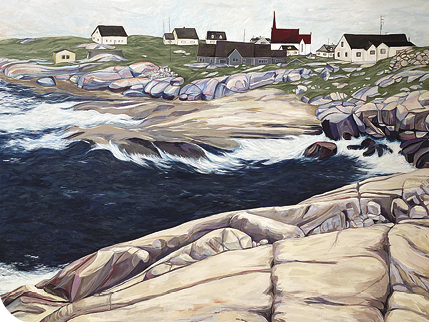

The 43rd Red Trillium Studio Tour will take place over the weekend of July 3 and 4, showcasing the studios of some of West Carleton’s most talented artists and fine craftspeople. Just twenty minutes beyond Kanata into the scenic countryside around Carp, Dunrobin and Kinburn, you will be welcomed at studios featuring paintings, jewellery, sculpture, photography, woodturning, pottery, glasswork, designer clothing and fine art textiles.
Artists will be on hand to discuss their work and tell you about their inspiration!
One of the stops on the Tour is The Olde Meeting House in Fitzroy Harbour, where you will be able to enjoy a take-out coffee and snack, in addition to meeting several artists. Several restaurants in the area are also offering great take-out breakfast and lunch options.
Visit <redtrilliumst.com> to download a list of the studios and map, and to see more information about the artists and craftspeople on the Tour. Red Trillium Studio Tour is also on Facebook and Instagram. Please note that all recommended Covid-19 precautions will be observed at each studio.

Dawn Dewar has been teaching Ottawa Valley Step Dancing for years, and when the pandemic made it impossible to do so in-person, she “pivoted” (dance pun intended) and decided to offer virtual classes. theHumm contacted her to find out more.
theHumm: Why were you drawn to traditional music and dance?
Dawn Dewar: I grew up on Ottawa Valley and Scottish Fiddle music. My parents were originally from Maxville in North Glengarry, ON. My father played the fiddle, and during my childhood he would bring the family to events where this music and dance were taking place — specifically fiddle and step dance contests throughout the Ottawa Valley.
This is where I fell in love with the dance.
I also saw how happy it made my parents. My sister and I fell in love with music right along with them, and it really created many happy bonding family moments.
When did you first start dancing?
Oddly enough, I didn’t really start dancing until well into my 20s. When I was younger, no one around me (in the city) knew what this was and none of my friends were doing it, so it was easy for me to forget about it when I would get back home from an event. But as the years went by I was really starting to itch for it, and knew I would regret it if I didn’t start!
I started teaching about twelve years ago when a friend of mine, who was also a dancer, asked me if I would like to help her teach. I was a bit nervous, but quickly got comfortable and fell in love with teaching. I’ve kept it up ever since!
I have taught private classes from my home, at the Chad Wolfe Dance studio, for the Munster Community Centre and most recently at the Nepean Creative Arts Centre.
What was involved in pivoting to offer online classes?
It was actually pretty simple. We use a Facebook Messenger video call (other options are available as well), and the student just needs their laptop and a dance floor. The sound and picture are quite good, so it works well.
What would a typical class involve?
I always work with each person’s skill set, whether they be child or adult. Whether you have lots of experience or are a beginner, I work very well with every skill set.
My intention with beginners is that they feel relaxed and comfortable. I’ve had teachers who tried to rush through things or get impatient when a student needs time, and this does not work. Being patient allows the student to get through the learning curve to see results.
I love to encourage and praise not just results but also effort, and I also love to have fun! We have great music to work with and my students and I laugh a lot.
How have your students responded to the new online format?
It was a bit of an adjustment at first because we would all rather be in person, but after the first few online classes we were off to the races.
Why do you think it’s important to keep people engaged in creative and fun activities even when we can’t do so in “traditional” ways right now?
This is so important. There are so many aspects to health and happiness. We must use what we have while other things are not available. This will keep your mood in check and will affect your hope for the future.
What we feed our mind and body always has an outcome. Let’s make it positive!
For more information or to register for Ottawa Valley Step Dancing classes, email Dawn at <learntostep@hotmail.com> or call 859–7869.
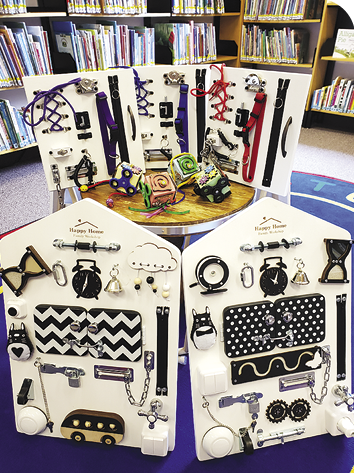
Summer Readingat the Lanark Highlands Library
The Lanark Highlands Public Library has had a very busy spring. We have continued to work on improving access to our collections through amended records in our online database as well as relabelling all our library books with larger, more accessible font sizes. We have also made some changes in how we shelve our materials. As an example, we have shelved our board books on the bottom shelf wrapping around our children’s area on so that the whole collection is in full reach of babies and toddlers.
We were fortunate to receive funding from the Kimberley Foundation as well as funding support from the Emergency Community Support Fund via ConnectWell Community Health and Community Foundations of Canada, to offering a book delivery service for customers who found it difficult to get to the library for any reason due to Covid-19.
The Kimberley Foundation also generously donated $2,060 towards our Sensory Play, Every Day initiative. This initiative involves incorporating sensory/tactile activity boards into our children’s area. We also have more portable busy boards, dementia boards and sensory cubes that we will use in programming and outreach initiatives. The fidget cubes and dementia boards are also available for loan!
Throughout the pandemic we have been running a mask fundraiser and to date have sold over 700 masks. This is an ongoing fundraiser, and patterns and our current stock is available on our website. Our masks are 2-layer, made with 100% preshrunk cotton and latex-free elastic, and cost $10. All proceeds go to the revitalization of the library.
If you haven’t already signed up your kids for our TD Summer Reading Program, it’s not too late! As part of our incentives program, we have had a 4-foot tall PLINKO board made. The more books the kids read, the more chances they have to play PLINKO to win prizes along the way and increase their chances to win one of our end-of-summer prize packs.
For more information, follow our Facebook page, visit <lanarklibrary.ca>, or visit us in-person (hopefully soon) at 75 George Street, 2nd floor in Lanark. You can also phone us for information at 259–3068 or email <general@lanarklibrary.ca>.
We really look forward to seeing everyone this summer!
Perth LibraryBuilds New Creative Space
While closed to the public, the Perth Library has been a bustle of activity. Notably, the non-fiction section was relocated downstairs, while teens have a redesigned space upstairs combining a lounge area, books, and a productivity centre.
This reorganization also offered the opportunity to revitalize the colloquially-known “Blue Room” as a creative space for all ages. This new space will house the library’s expanding collection of “things’’ and serve as a bookable room dedicated to creative ventures. The library is looking for help in creating a fun name for this new room that captures both its function as a makerspace and library of things. Ideas can be submitted throughout July at <perthunionlibrary.ca/library-of-things>.
“The library has a growing collection of ‘things’. You can borrow a Chromebook, WiFi hotspot, e-readers, museum and parks passes, even a Kill a Watt Meter!” explains Emily Smith, the library’s adult and senior services specialist. “This new room will house our library of things and be a place for creativity! In Step 3 of the provincial Roadmap to Reopening, we look forward to opening this new room for bookings. Anyone can book the room to use our in-house equipment, including a Cricut 3D printer, or a die-cutter, or bring your own project.” The new room can be booked through the library’s website at <perthunionlibrary.ca>.
Have a musical instrument you’re not using? Craft supplies gathering dust? Donations to the library of things are welcome. The library’s current wish list includes: a GoPro or comparable action camera, specialized craft equipment, knitting and crochet tools & accessories, snowshoes, an industrial grommet tool, binoculars, a sewing machine, sheet music, percussion instruments, a floor easel and a portable CD player.
The library is seeking individuals with knowledge and experience in the maintenance of musical instruments to volunteer in a casual capacity. The library also welcomes partnerships with community members who have something to share or teach to others. Visit <perthunionlibrary.ca> or contact <esmith@perthunionlibrary.ca> to inquire about the Library of Things!
Summer is upon us, and this is the time for blockbusters and money-makers, for a quick escape into the dark cool movie theaters, supplying crisp air and buttery popcorn, for movie lovers to gather and… oh yeah, that’s right. Covid. Well, maybe not the theatre, then. On the bright side, we can still see these movies at home, or on whatever device may be your weapon of choice. Whether you miss the social exchanges or prefer the intimacy of your living room, we still got the movies! And there has been quite a slew of releases lately. Majority of them, if I’m being honest, I am thrilled I did not have to pay admission to (I’m looking at you, Cruella). It is comforting, in a strange way, to see continuously see unoriginal, misguided, monotonous schlock oozes out of the Hollywood pipeline. Consistent if nothing else. What these films provide, aside from time wasted, is an appreciation for those films that are brave and unwavering in their fearlessness and determination. Anyways…
Starting off on a positive note, the action blockbusters have not disappointed for the most part, and the horror films are all slightly above par, which is a relief. Nobody came as a surprise. I knew Bob Odenkirk could do pretty much anything, but an action hero was not what I expected, and Odenkirk really delivers. He uses his dry sarcasm to great effect and looks pretty damn good beating the crap out of some Russian punks. I expect Nobody 2 in a couple years. Boss Level is another unexpected action flick that seemed to have eluded my radar. I have been a fan of director Joe Carnahan ever since Narc (2002), and he has proved himself a talented filmmaker and storyteller with flair (Smokin’ Aces in 2006, The Grey in 2011) but also can be excruciatingly self-indulgent (The A-Team, 2010; Stretch, 2014). With Boss Level, Carnahan returns to his focused, testosterone-infused best. And he’s found a perfect actor to carry out his plans in Frank Grillo. Grillo commands every frame of the film with a strong physical presence and good sense of humor. The film is basically Groundhog Day on steroids. And it’s a heck of a lot of fun. Welcome back, Joe. Oh, and Mel Gibson’s in it, too, in a solid villainous role.
Chaos Walking (by Doug Liman and starring the surprisingly versatile Tom Holland) is a film that really shouldn’t have worked. It’s more interesting and less aggravating that it has any right to be. All this is helped by Mads Mikkelson in yet another great performance. You could just have him stand there and say nothing and he’d be compelling. Oh yeah, he already did that in Valhalla Rising. Mads is the man. For a sci-fi action flick, it doesn’t get bogged down by any fancy rhetoric or over-your-head terms. It is all very grounded and human. The only real problem in the film is Daisy Ridley, who seems to be capable of only a handful of facial expressions and lacks any sort of charisma. Had there been a more capable actress in the role, this may have become an underrated classic. But for now, it seems like it’s another good creative effort for Doug Liman.
Zack Snyder released two epic films this year as well — his long-awaited version of Justice League and a return to zombies (and hopefully, a return to form) with Army of the Dead. While Snyder’s Justice League is an immeasurably better film than Joss Whedon’s horrible handling of the material four years ago, the film still seems overly indulgent and a good 30 minutes could have been cut out. I mean, I know Snyder loves his slow-motion shots, but I can only watch Jason Momoa get hit by waves before he jumps into the ocean for so long. Still, everything was improved upon. I actually understand what Steppenwolf was doing and felt a little empathy for him. And all the big characters in the League have fleshed out stories and, well, everything makes sense now. It goes to show taking your time and caring about your material can go a long way (Mr. Whedon…).
On the other hand, we have Army of the Dead. When I heard Zack Snyder was releasing this movie on Netflix I got very excited. I was introduced to Snyder through his beautiful gorefest Dawn of the Dead (2004). Since then, he has proved he is capable of creating visual masterpieces like 300 (2006) and Watchmen (2009), but is also capable of creating distended, derivative crap like Man of Steel (2013) or Batman V Superman: Dawn of Justice (2016). And it pains me to say that Army of the Dead falls sadly into the latter category. The film has so much going for it but is focused too heavily on style over substance. When it did try to add substance and humanity, it became laughable and dull. And most of the scenes that were supposed to be funny weren’t. I didn’t care about any of the characters and the writing was atrocious. Yes, it had a neat kind of twist on the zombie genre. Yes, there was a really cool zombie tiger. And yes, it has some of the best zombie kills I’ve been since the first few seasons of The Walking Dead. But that’s not nearly enough to save it. Plus, it was just way too long. Call me crazy, but I feel that a good zombie flick should be a tight hour-forty-five. Army of the Dead is two-and-a-half hours. 45 minutes could have been cut out and nothing of value would have been lost.
With this nice little segue into the horror genre, some pretty decent horror films got released over these last couple months. The Saw franchise continues its bloody traditions. In hopes of rejuvenating the series, they’ve cast Chris Rock and Samuel L. Jackson and have made a crooked police department the focus of Jigsaw’s always-insightful wrath. It’s called Spiral: From the Book of Saw. I can report with pleasure that it delivers a lot of what you expect. Dark and creative. But I can say with dissatisfaction that it doesn’t bring anything new to the table. Chris Rock here is the best I’ve seen him. He’s fine at what he does. But when you see him beside Sam Jackson, you can’t help but notice the difference. Spiral is one of the better entries in the series… but it’s still just another entry in the series.
If I had to pick the best film I’ve seen in 2021, I would have to nominate, without hesitation, Guy Ritchie’s Wrath of Man. Here is a film that took me by surprise. For me, his creative and brilliantly innovative style is endlessly fascinating. I figured Wrath of Man to be no different, but what I was presented with was a tightly wound story — one story, with a focus I have not seen in a Ritchie film before. He took his time with the actors, he focused on the characters. It wasn’t flashy and kinetic. Sure, it had Ritchie’s trademark tough guy talk and manly man banter, but even that seemed to have a deeper purpose. Is this perhaps because the film is a remake of the 2004 French thriller Le Convoyeur (Cash Truck), and he didn’t want to offend the original filmmakers by butchering it with his particular style? Or maybe he saw a simple, compelling story that he wanted to tell himself, and perhaps even expand on it a little. And boy, did he. Here is a story of a stranger (we only know him as H.) who gets a job at a cash truck company and fits right into the job. Almost too well. We soon find out why. And it’s glorious. When it all comes together at the end, there is such a sense of exhilaration. Elation. That nagging feeling you get between your shoulder blades that creeps down your spine, sending signals of sizzling anticipation. With a precise, powerful and unblemished ending. This is also one of Guy Ritchie’s finest, most mature films. What I’m saying is, when you get a chance, watch Wrath of Man.
Good movies aside, I can’t resist talking about the blunders, the missteps, the turkeys — the ones that met every one of my cynical expectations. But I really just want to talk about one. I mean, the Mark Wahlberg vehicle Infinite is an incoherent mess and The Woman in the Window is painfully predictable and an absolute waste of talent, but it’s Disney’s Cruella that I want to give special mention to. Here is a film that didn’t really need to be made. You could say it’s the epitome of a money-grab or a gamble that didn’t pan out. You could say it’s the rich and visually arresting origin story of Cruella DeVil, the villain of Disney’s 101 Dalmatians (1961), who, I remind you, wanted to kill those dogs so she could make coats out of their fur… but I digress. Or you could say it’s a garish, uneven steam-punk daydream origin story gone wrong. Cruella doesn’t have a single relatable character, no grand victory for our protagonist (and I use the word protagonist lightly), nothing gained, nothing lost. Any semblance of a plot was destroyed in a shower of costumes and dresses. I’m not sure who the target audience for this film is exactly, but if you’re an angsty tween who’s into fashion and punk rock, this is probably gonna be your favourite film of the year. The only redeeming factor come in the shape of the ever-reliable Emma Thompson. Here she shines at her bitchy best. Still not enough to save this massacre. Why Disney greenlit this will forever boggle the mind. Avoid the anguish by avoiding this film.
All that being said, happy movie watching!
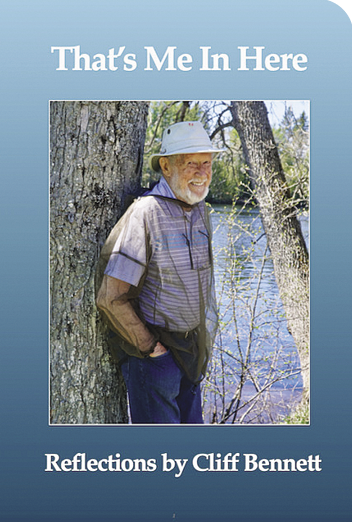
Cliff Bennett, a lifelong resident of the Almonte and Carleton Place area, has written a collection of his memories called That’s Me In Here. Over the past 89 years, Cliff has been active in countless local and provincial committees and groups such as Scouts Canada, the Carleton Place Canoe Club, Ontario Heritage, Almonte curling and lawn bowling clubs, politics, and the Mississippi Valley Field Naturalists, to name a few. Accountings of these involvements, as well as memories of growing up in Carleton Place and world travels, are found in his book.
Cliff is taking his accomplishment one step further by deciding to sell the book for $25, plus shipping, and donate all the profits to the Mississippi Valley Field Naturalists’ Cliff Bennett Nature Bursary Fund, which is awarded to local high school graduates who are going on to careers in nature-related programs in university or college.
People interested in purchasing That’s Me In Here can do so by contacting Cliff Bennett at <bennettcliff1772@gmail.com>.


Strévé Gallery Celebrates Canadian Local
In celebration of Canada’s Birthday and the Support Local Movement, Strévé Design Loft Gallery is featuring three Perth area artists and artisans during the summer months. Owner Cheryl Straby explains that: “supporting local emerging and professional artists has always been the mandate of the gallery since moving into my wonderful space three years ago. I guess that’s reason enough to celebrate!”
Featured in the loft gallery is oil painter Chris Lemaire, who recently settled in Portland on the Rideau from the Avalon area of Newfoundland where he was inspired to paint the ocean, wharfs and rural life as well as wilderness areas. Chris is also a steel artist, using cold rolled steel, welding and freehand plasma cutting to develop a 3-dimensional effect. He paints with fire to develop the colours in the steel. This is the first time Chris has exhibited his artwork outside of Newfoundland.
Perth hand weaver Lise Loader first exhibited in the gallery during last summer’s successful Weavers Unlimited exhibit. Lise has continued to exhibit and sell her uniquely beautiful handwoven scarves and shawls made of natural high quality fibres ever since. Lise started weaving in 1988 in Toronto, and since moving to Perth in 2007 has joined the MERA weavers and the Kingston weavers. Lise believes that weaving is a perfect medium to express oneself by playing with colours and fabrics.
Anyone who has visited the main floor boutique over the past three years will have noticed Perth jewellery designer Eleanor Martin’s stunning one-of-a-kind semi-precious stone, lampwork beads, freshwater pearls, fine and sterling silver necklaces, bracelets and earrings. Eleanor’s strong sense of design and love of fashion eventually led to a Couturier Certification and a teaching position in Haute Couture at Richard Robinson in Ottawa. Many clients wanted necklaces and bracelets to go with outfits she was creating in her own business, and this led to her designing jewellery.
Eleanor Martin’s jewellery and Lise Loader’s scarves coordinate perfectly with Cheryl’s own ready-to-wear and artwear clothing and accessory collections that she creates under her Strévé label. All her pieces are created in her studio located at the back of the boutique. Chris Lemaire’s artwork is adding an extra punch of excellence to the lineup for this summer’s exhibit, which runs until August 25.
Explore your own backyard this summer and be delighted by Canadian Local at Strévé Design Studio Boutique and Gallery at 64 Gore Street East in the heart of beautiful downtown Perth, beside the town hall.
William Liao: Lower Mainland
From June 23 to July 30, Sivarulrasa Gallery is pleased to present William Liao: Lower Mainland, a solo exhibition of new paintings by Vancouver-based artist William Liao. The exhibition can be seen in-person during regular gallery hours: Tuesdays to Sundays from 11am to 5pm.
William Liao’s subject locations are found throughout British Columbia’s Lower Mainland, including Vancouver, the Fraser Valley and surrounding areas. The life of the city and its urban core are inspirations for several of the paintings. The artist also seeks out the solitude of the ocean and natural spaces such as Stanley Park that are within the city or a short drive away. “Canada is a place where people and nature live in harmony”, he notes.
Liao grew up in Beijing, China. He graduated from Beijing Normal University with a Bachelor of Arts degree, majoring in Fine Arts. Having been raised in China after the Cultural Revolution, his work is influenced by both Eastern and Western traditions in art, employing an exuberant colour palette, dramatic contrasts and bold brushstrokes. Much of his work can be viewed through the lens of a newcomer, displaying themes of both displacement and euphoria.
Everyone is invited to meet the artist (virtually) on Saturday, July 3 from 3–5pm. There will be an informal drop-in session at the gallery, with Liao joining live via video link from his studio in Vancouver. Feel free to stop by and pose your questions to the artist during this time. Please note: Ontario’s Phase 2 rules for re-opening will be in place by this time, so only six patrons can be allowed in the gallery at a time.
Bittersweet Summer Plans
This summer, Bittersweet Gallery in Burnstown presents yet another stellar jewellery collection by Montreal designer Anne-Marie Chagnon, showcasing the ever-changing inspirations and influences that mark the path of this artist. Propelled by an urge to celebrate the infinite nuances of nature, these new pieces embrace a true paradox between bold and delicate. Because nature is a poised balance of both. Because every human being delineates this equilibrium. This balance is very much evident through the use of modest pieces like the metallic link (Anne-Marie’s version of the timeless medallion etched with her own design), as well as the classic cornicello (an ancient amulet or talisman that was once worn for protection and to maintain peace and happiness).
The 2021 collection is one of movement and unison. A cornucopia of lightweight chains that gracefully caress the neckline in a fluid water-like manner, the jewellery sways to the rhythm of the wearer and melds into every move. Through colour, form, material and size, this collection plays on many possible variations and personalization. Bittersweet Gallery is known to carry the largest collection of the artist’s work in Ontario and is the first to feature both the spring/summer and fall/winter 2021 collection.
Then in August, Bittersweet Gallery will present the 49th annual show of relief sculptor Richard Gill. Coastal Cornwall will open on Saturday, August 21 outdoors on the grounds of the gallery, and will include several invited guest artists who will be announced soon. Find directions and details at <burnstown.ca/bittersweet>.
The Plenty Canada team is excited to announce the third year of their Truth and Reconciliation Training Program for Indigenous and non-Indigenous youth aged 15-30!
This year’s program will run from July 2021 to March of 2022, with both online and on-the-land offerings designed to ensure the safety of all participants as we adapt to the new and evolving Covid reality. In a small group of like-minded youth, participants will get a unique opportunity to hear from and learn alongside leading Indigenous Change-makers, Artists, Elders and Knowledge Holders. This program is a hands-on opportunity to learn about different Indigenous traditions, innovations, leadership and culture. Students will also get an opportunity to develop a community engagement project with mentorship and support from Plenty Canada staff as well as fellow program participants.
More details can be found at Plenty Canada’s website: <plentycanada.com/trtprogram.html>.
From July 17 to September 18, the Mississippi Valley Textile Museum presents exhibitions of works by Murray Gibson and Donald Stuart.
Murray Gibson is a master artisan and member of the Royal Canadian Academy of Arts. The tapestries in Cloth and Consequence represent an exploration of female literary figures who are textile practitioners, and how their practices affect the fates of others (often men) or of themselves.
Donald Stuart is one of Canada’s leading gold and silversmiths. His works are inspired by outstanding Canadian women. Homage to Canadian Women is a collection of 40 framed neck-pieces created by the artist as a celebration and tribute to Canadian women, past and present.
These are the first in-person exhibitions to be mounted by the Museum since the start of the pandemic. Please visit <mvtm.ca> or call 256–3754 for more information or to learn about safety protocols.
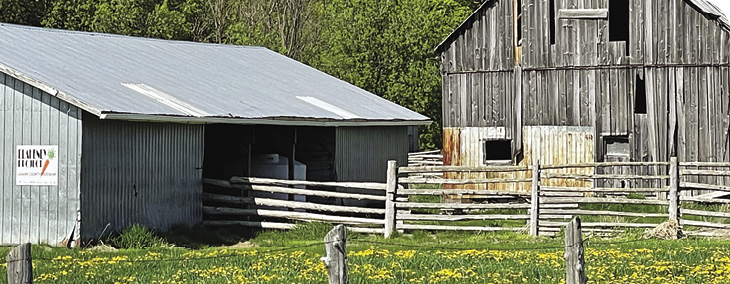
I wrote a few months ago about the Blakeney Project — a two-acre field in Blakeney that has been leased (free of charge) to the Lanark County Food Bank (also known as the Hunger Stop) to grow fresh food for the community.
Notwithstanding the fact that progress has exceeded our wildest expectations, we have faced a few challenges, including:
A somewhat later start in planting than we would have liked while waiting for the relatively heavy soil to dry.
An almost complete lack of rain in April and May. Ottawa airport records show a total of 7cm (parts of the Ottawa Valley received much less) — this compares to the 22cm that most crops would require over the two months. In order to complete putting in transplants we were forced to buy a truckload (3500 gallons) of water. While expensive, it did show that it is doable.
Delays in creating our water collection system and our in-field irrigation system (a complicated system that involved several contractors). We are very grateful for one of our team members who is quite tenacious in chasing contractors!
An almost complete failure of many of the crops that we planted from seed such as carrots, beets and chard due to the very dry conditions. On the bright side, we received donations of thousands of beautiful plants to fill the empty beds.
Back to the progress side. By the end of June, we had planted virtually all of the 1.6 acres that we were able to have plowed and tilled. We have drip irrigation on one-third of an acre where we have planted tomatoes, peppers, beans, zucchini and cucumbers. The remainder is planted primarily in potatoes, corn and squash, and will have to depend on Mother Nature for moisture. We have tried to work with nature — for example, planting potatoes eight inches deep, close to the moisture that the decaying sod will provide. As Ed Lawrence has opined, he does not want to be part of the work team harvesting these potatoes.
The most amazing success story of the project so far has been the people side!
There are 25 folks who form the front-line — these are the people who get out there with shovel, hoe and rake; who get down and dirty and commit to a weekly three-hour shift throughout the growing and harvesting season. These regular shifts started in late May.
These folks come from all walks of life and all ages, but most do not have a great deal of gardening experience. We have a pretty fair gender balance, and several folks volunteer as couples. We do find that there is a bit of competition among the guys to drive the lawn tractor and yard cart…
Behind the front line is our Core Team of ten to twelve experienced gardeners who started the planning in late January via a Zoom call and have faithfully participated in a call every two weeks. There have been all kinds of tasks that have pushed the team beyond our comfort zone. These are the people who have done the research on appropriate equipment and materials, mapped the layout of the garden space, chased contractors and equipment suppliers, designed a shed, got a building permit and built it, obtained three very large tanks (1250 Imperial gallons each) and set up an irrigation system, and led teams of keen but inexperienced volunteers.
And behind the Core Team is the ultimate authority of the Board of Directors of the Food Bank. The Board receives regular monthly reports and has access to minutes of the bi-weekly Core Team meetings. One Board member has been remarkably successful in writing grant applications, our Chair tracks expenditures and posts progress on Facebook, our Treasurer tries to keep us on budget, and other Board members ensure that we meet Health and Safety standards and that necessary paperwork is in place.
We have been extremely fortunate to have the organizational skills of our Food Bank Manager, who organizes our volunteers and gets them to fill in forms and commit to a regular time slot (and who chases people to fill in when regular volunteers take some time off).
Now that we have become convinced that we may have something to harvest, some of the focus is shifting to processing and storing of the produce. But of course, we are not ignoring the necessary weeding and cultivating.
It’s not too late to join our teams of volunteers — just phone the Lanark County Food Bank (the Hunger Stop) at 257–8546.


At first glance, Audrey Kealey and Jordan Waito don’t appear to have much in common.
Audrey is 81. Jordan is 22. Audrey is retired and lives in Carleton Place with her husband Brian. Jordan is single and lives in Kanata.
What the two do have in common is often considered to be a “once in lifetime” occurrence. Both Audrey and Jordan have won big on a local hospital lottery.
How big? Each walked away with a car thanks to their support of the Hospital Lottery, now known as Win2021, presented by Almonte General Hospital Fairview Manor (AGHFVM) Foundation and Carleton Place & District Memorial Hospital (CPDMH) Foundation.
In 2018, with the generous support of Keith Bean of Bean Chevrolet in Carleton Place, the two hospital foundations presented Car or Cash for Health Care. Old-style paper tickets were sold for $20 for one and $50 for three. Almost 6,500 tickets were sold. On Friday, Oct. 5, 2018, hundreds of ticket buyers had packed the Almonte Civitan Hall for a touchdown party, and to see if they would be the big winner.
Jordan, and his father Jeff, were not in attendance. They had bought their tickets several weeks earlier while attending the National Capital Car Show where the grand prize was on display.
After being called by Robyn Arseneau, Executive Director of the CPDMH Foundation, Jordan, his father and girlfriend came to the Civitan Hall that evening to claim their dream prize — a convertible 1967 Firebird appraised at $30,000.
“It was cool winning a car, especially a rare car like that. My dad had that exact same ’67 Firebird as his first car ever so it was a blast for both of us to drive,” said Jordan.
Audrey Kealey’s win last year in the Win2020 Hospital Lottery had some sentimental value as well. Her husband Brian had bought a ticket for her as a present. Brian thought Audrey would be extra lucky because the draw was taking place on July 9, her 81st birthday. He was right about the extra luck. Audrey won the grand prize, a convertible 2020 Camaro valued at $50,000, again provided by Bean Chevrolet of Carleton Place.
“It was just wonderful winning that car on my birthday,” said Audrey. “I have so much fun cruising around with the top down and the wind blowing my hair. We’re lucky to have Keith and April Bean supporting our hospitals.”
All of the tickets were sold online last year. They were one for $25 and five for $100. The tickets sold out in 33 days. As a result of the pandemic, last year’s draw was held outside under a tent at Bean Chevrolet. The Kealeys live nearby, so getting them over and showing them their beautiful new car only took minutes after they were called with the good news.
This year’s Win2021.ca has a total prize value of $96,000. The grand prize draw announcement of the winner of a 2021 Blazer takes place on Thursday, July 8 at 6:30pm at Bean Chevrolet in Carleton Place. It will be broadcast live on the Facebook page of each Foundation. Tickets are one for $35 and three for $100.
All proceeds from the Win2021 Hospital Lottery will be shared equally by Carleton Place & District Memorial Hospital Foundation and Almonte General Hospital Fairview Manor Foundation and used to purchase replacement or new clinical equipment. To date, more than $250,000 has been raised with Bean Chevrolet’s support.
If you don’t think you’d ever win, think again. By supporting the hospital, everyone wins! Tickets are available at <win2021.ca>.